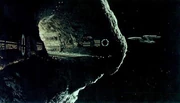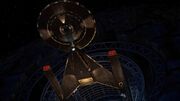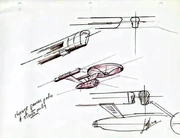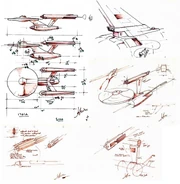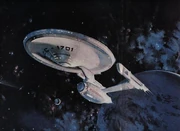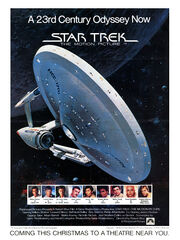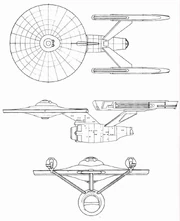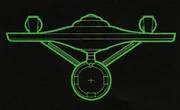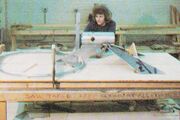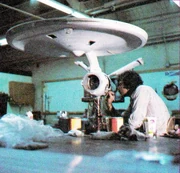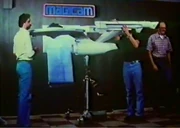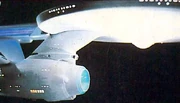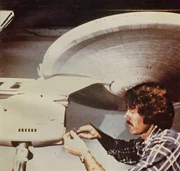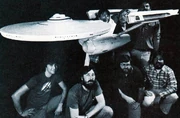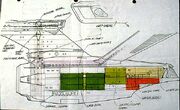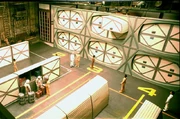(written from a Production point of view)
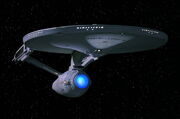
Constitution II-class studio model
The studio model that represented the Constitution II-class USS Enterprise was slated to be modernized and redesigned after the production of Star Trek: The Original Series and Star Trek: The Animated Series, following the success of the Star Trek franchise in mid-1970s syndication.
At first, a radically different starship configuration was seriously considered for Star Trek: Planet of the Titans, a proposed Star Trek continuation, before Matt Jefferies' classic design was revisited for Star Trek: Phase II, the project that ultimately lead to Star Trek: The Motion Picture.
Originating with traditional physical studio models, CGI models were also used to represent ships of this class later in the franchise's history.
Early concepts: Planet of the Titans[]
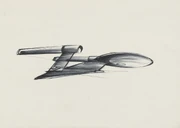
Adam's Enterprise concept
Ralph McQuarrie, best known to the public for his stunning production designs for the Star Wars films, was hired by the renowned production designer Ken Adam to help develop Adam's designs for the then-proposed Star Trek: Planet of the Titans movie, ultimately abandoned to make way for Star Trek: Phase II.
Although the design used the same elements as the original design, including the saucer-shaped primary hull, warp engine assemblies, and a secondary hull engineering section, Adam's secondary hull was flattened and wedge-shaped, providing a radically different look, not unlike the Star Destroyers that McQuarrie helped to design for Star Wars.

|

|
Interestingly, McQuarrie envisioned the designs as capable of performing a saucer separation. He remarked, "I had devised a concept for the end of the film… Some alien form has designed a way to use the power of a black hole's gravity to form a spherical shroud around the black hole. If you have a dense enough material, gravity cannot penetrate it. There are two openings in the shroud that they would use to pull ships in. The saucer of the Enterprise (which was detachable) ends up in the shroud. They meet the aliens and had a dramatic finale. These two images are of the Enterprise saucer in the shroud.(…)The disc of the Enterprise would separate from the rest of the ship to land on the surface of planets." [1] McQuarrie's sketches of the independently operating saucer section were published in The Art of Ralph McQuarrie (pages 124-129).
Planet of the Titans models[]

|

|

|
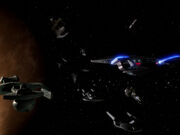
|
Based on McQuarrie's refinements of Adam's Enterprise concept designs for the Planet of the Titans project, at least two study models were constructed before the project was shelved. Former Cinefex reference author Kevin H. Martin, has identified British visual effects artist Derek Meddings (of Gerry Anderson Productions fame such as Fireball XL5, Stingray and most notably Thunderbirds), as the production staffer slated for Planet of the Titans studio model construction, so it is presumed that it is he who constructed the models. [2](X)
Stored away for the better part of a decade, both models would make surprising reappearances. Although stated as having both made an appearance in the Battle of Wolf 359 aftermath debris field, featured in Star Trek: The Next Generation's season four episode "The Best of Both Worlds, Part II", they have not been identified as being there. (The Art of Star Trek, p. 56; [3]) The aft of one of the models could partially be seen however, in Star Trek III: The Search for Spock, a the ship docked behind the hub in Spacedock One in the scene where the Enterprise entered. A full dorsal view of the other model was seen in the The Next Generation season five episode "Unification I", where it was present as B-24-CLN at the Surplus Depot Z15.
The B-24-CLN study model, constructed out of wood and plastic, detailed with hand-applied tape and ink and measuring fifteen inches in length by eight inches wide, eventually turned up on 8 August 2010 as Lot 12 in the Propworx' The official STAR TREK prop and costume auction, estimated at US$1,000-$2,000, where it sold for US$3,500.
Legacy[]
Assumed to be relegated to Star Trek production history as a footnote, the Adam/McQuarrie Enterprise design for Planet of the Titans, especially McQuarrie's elongated one, made a surprising later re-appearance nonetheless. On 23 July 2016, a teaser trailer for the new Star Trek: Discovery television series, slated to debut the following year, was shown by then showrunner Bryan Fuller at the San Diego Comic-Con. [4] [5] In it, the new "hero" ship, the proof-of-concept CGI model of the USS Discovery (NCC-1031) was introduced, which bore an uncanny resemblance to the one designed by McQuarrie four decades earlier. Not only that, but the new ship was seen launched from a strikingly similar asteroid spacedock, also already envisioned by McQuarrie for the abandoned movie project.
The striking similarities were not lost on the more knowledgeable Star Trek fans, who immediately afterwards reported this, including at the press junket directly following the teaser presentation and where the question was already raised for the first time, and subsequently on more than one internet blog, including those of TrekMovie.com and TrekCore. In response, Fuller was at first unable to confirm this, as the producers at that point in time "legally can’t comment on it until we figure out some things". [6] Nevertheless, less than a month later, Fuller himself already started to implicitly concede the point when he mentioned the McQuarrie designs as "inspirations", continuing to stress though, that the design process was not yet final and still in development. [7]
Only after the new series had premiered in September 2017, was firm confirmation provided, that the Adam/McQuarrie designs were indeed the starting point for the eventually featured and indeed further evolved Crossfield-class, most notably the USS Discovery herself. It was class designer John Eaves who provided the confirmation, furthermore divulging that a third sketch from Paul Christopher was concurrently serving as the design starting point. Stated Eaves, "He'd done a real quick, rushed sketch. It was just a whole bunch of basic stuff – a little Federation stuff, a little Klingon stuff. He had that on the wall and it was a bit of a departure from the McQuarrie and Adams [sic.] one." (Star Trek: Discovery The Official Starships Collection, issue 2, p. 8)
Designing a refit Enterprise for Phase II[]
When the Planet of the Titans project was canceled, so was its Enterprise design, and Roddenberry asked Matt Jefferies to update the famous starship to reflect the refit that would be part of the Phase II-series' backstory, while keeping the overall look that Jefferies had established in his classic Original Series design. During June 1977, Jefferies, who had agreed to return to the franchise on a temporary basis as "Technical Advisor", redesigned the engine nacelles, changing the nacelle tubes into thin, flat-sided modules and tapering their supports. He also added a distinctive phaser emitter at the base of the pylon connecting the saucer and engineering hull (which evolved into the familiar photon torpedo tubes after Jefferies’ design was revised for Star Trek- The Motion Picture) and dispensed with the protruding deflector dish.
"Basically," Jefferies said, "what I did to it was change the power units, and make a slight change in the struts that supported them. I gave the main hull a taper, then I went flat-sided and thin with the power units, rather than keeping the cylindrical shape. Trying to work out the logic of the refit, I knew a lot of the equipment inside would change, but I didn't see that there would be any need to change the exterior of the saucer. Certainly, though, the engines would be a primary thing to change. Part of the theory of the ship's design in the first place was that we didn't know what these powerful things were or how devastating it would be if anything went awry, so that's why we kept them away from the crew. And that meant they could be easily changed if you had to replace one." (Star Trek Phase II: The Lost Series, p. 27) Elaborating he later clarified, "As far as I was concerned, about the only thing we could update was the engines, So I changed the design of the pods and the struts. I still wanted an absolutely plain exterior. Anything that man makes is going to break down; why put him outside in the worst possible environment when you can put him on the inside?" Jefferies started work from a drawing he had actually prepared for the Original Series back in 1964, already showing the Enterprise with swept-back, flattened nacelles, to be presented to Roddenberry if he did not like the first version, appropriately annotated with the remark, "change power pods [note: as the nacelles were at the time still called, the terminology carried over from The Original Series] & struts only". (Star Trek: The Magazine Volume 2, Issue 8, p. 84) Jefferies later sold off his redesign sketches, together with the original alternate one, on 12 December 2001 in the The Star Trek Auction, in order to raise funds for the charity organization "Motion Picture and Television Fund".
Unlike the first redesign of the Enterprise, Jefferies' new version, subsequently elaborated upon in production art work by Mike Minor and Joe Jennings, was therefore designed along the classical lines of the original, albeit modernized. Having already worked with him during the second season of The Original Series, Jennings was brought in as art director on recommendation of Jefferies, after the latter expressed an unwillingness to leave his then job at Little House on the Prairie, in order to help out with the re-design work. Jennings in turn brought Minor on-board in August. (Star Trek Phase II: The Lost Series, p. 26).
But when Paramount Pictures abandoned its plans to create a fourth television network in late July 1977, they subsequently transformed the second Star Trek series into a television movie before it morphed into the first theatrical movie feature in mid-November 1977, ultimately announced to the general public on 28 March 1978. The last upgrade decision was first and foremost influenced by the run-away success of the first Star Wars film in 1977. Studio executives discerned that part of its success were the highly detailed studio models used in that movie, and wanted the notion carried over to the new Enterprise as well. This notion however, was vehemently opposed by Jennings, stemming from his philosophies on the visual look of science fiction productions, who fought the notion tooth and nail, as he recalled decades later,
"With science fiction, you establish a frame of reference, and then you be as honest as you can be within that framework, and you'll achieve a believability you can not do any other way. And you also have to remember that you are not dealing with magic. It can't just look like whatever you want it to look like. Then we got into the new film thing, and meanwhile a show called Star wars had come out, with a whole different category of ships, what we at that time had been calling "junk ships". Not in a derogatory sense, but because they were made up of all sorts of little bitsy pieces all over, so they looked very, very busy. And I had a real war on my hands, because I was fighting a successful show and Hollywood's executives had a tendency to go with a proven thing. But my idea was, Star Trek was established and has always been the crisp craft. And by that time Star Trek was part of the American culture and if you're gonna tell a story where you have Little Red Riding Hood, she can't be accosted by a goose, it's gotta be a wolf, and a wolf always looks like a wolf. So I won the argument and the Enterprise stayed looking pretty slick." (Star Trek: 45 Years of Designing the Future)
In essence, Jennings had re-fought the same battle original designer Jefferies – who had already left the production by this time in order to return to his regular job – had fought back in 1964, when he too had to fight off producers who continuously wanted to encumber the original Constitution-class design with additional hull detailing. (Star Trek: The Magazine Volume 1, Issue 10, p. 25)
That left the design of the Phase II Enterprise as is, but the studio model of it, already in the process of being built, was discarded when Phase II Post-production Supervisor Paul Rabwin brought in a new visual effects (VFX) designer/art director, Richard Taylor, who enlisted the help of Andrew Probert to do a second co-redesign of the ship, essentially keeping with Jefferies' new lines, though adding the extensive detail that was necessary for a motion picture miniature to meet big screen requirements. Probert recalled, "When I started the design phase of the Enterprise, my Art Director, Richard Taylor, showed me these pictures of the ship as it had been designed by Joe Jennings and Matt Jefferies for the Star Trek Television movie now known as: 'Phase II'. He also produced plans of the ship and I was told that this would be our starting point. Since this four [sic.] foot miniature was made for a 20 inch television screen, it would have worked just fine but our miniature had to hold up on a 40 foot movie screen, so we started our eight foot version from scratch." [8](X) The deliberations of Wise and Taylor eventually led to the decision to abandon both the design and the model of the Phase II model.
Even though the Phase II filming, or studio model was discarded, its design, surprisingly, showed up canonically as ship's operations graphics read-outs on bridge computer consoles in both The Motion Picture and The Wrath of Khan (among others clearly discernible in the Mark IV bridge simulator). The green back-lit transparencies were based upon a set of orthographic schematics, probably done at Price's model shop for familiarization purposes. It is not exactly clear why they were used, as the back-lit transparencies based on Richard Taylor's schematics (which were predominantly in blue) of the revised follow-up motion picture studio model also appeared alongside them in the features, but since they apparently had already been produced for the Phase II project, it was undoubtedly a movie re-use for cost efficiency considerations. The original dorsal back-lit transparency, measuring 19½ × 15 inches and constructed out of Lexan with green gel according to its auction description, turned up at auction as lot 635 in the 15-16 December 2012 Profiles in History Hollywood Auction 53: Drama, Action, Romance, estimated at US$1,500-$2,500. It went unsold. Similarly, a frontal view transparency Phase II graphic, likewise featured in the Wrath of Khan, was previously offered up for auction in Profiles' The Ultimate Sci-Fi Auction auction as lot 155, estimated at US$1,500-$1,800, ultimately selling for US$3,250 (excluding buyer's premium) on 26 April 2003.
Phase II model[]
Initially, the studio toyed with the notion of reusing the actual Original Series eleven-foot Enterprise studio model for Star Trek: Phase II, which was donated to the Smithsonian Air and Space Museum only three years earlier. The museum, rather wisely in hindsight, refused to give the model back, especially since it was part of the permanent "Life in the Universe" exhibition in Gallery 107 at the time. (Enterprise Incidents, issue 13, p. 19; [9](X)) Phase II Producer Robert Goodwin reported in a progress memo dated 8 September 1977, "The original Enterprise will remain in the Smithsonian, but we are trying to borrow back the Klingon Battle Cruiser [note: which they succeeded in doing], which is also there, but not on display. Meanwhile we're having a new model of the Enterprise constructed, with the added bonus of a saucer section which can separate from the engine nacelles, should such a maneuver be a necessary part of some story. This capacity of the Enterprise was described in The Making of Star Trek, although it was never utilized in the first series." (Starlog, issue 11, p. 39)
While Matt Jefferies was working throughout the summer of 1977 on his redesigns, Goodwin reported the following state of affairs as it then stood to Gene Roddenberry in a memo dated 3 August 1977,
"About 75 percent of the details of our new model Enterprise have been worked out by Matt Jefferies. The model will be five to six feet long and while it will have basically the same configuration and shape as the old Enterprise, there will be a number of modifications and updatings that will give it a more sophisticated and slightly different look. The power pods [note: as the warp nacelles were still called at the time, the expression carried over from the Original Series-era] will be designed slightly differently. The phaser banks will be located in the main strut of the ship as opposed to the bottom of the saucer as it was previously and probably there will be other changes as work progresses. Construction of the model should begin in five to six weeks. Matt Jefferies is currently searching out various model builders available to us, so that once drawings are completed we can get in some very quick bids and work can start without delay. At the same time Matt is involved with work on models of various planets which will be worked in conjunction with our Enterprise model." (The Making of Star Trek: The Motion Picture, p. 37)
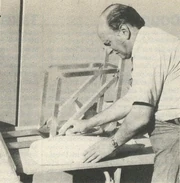
|
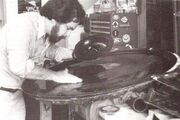
|
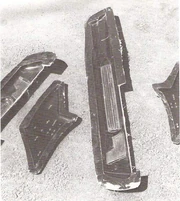
|
Goodwin's "model builders" turned out to be Paramount Pictures' own visual effects company, Magicam, Inc which was awarded all the VFX work for the project at the start of September. Upon final approval of Matt Jefferies' redesign of the ship, detailed construction blueprints(X) , based on Jefferies' preliminary redesign sketches, were drawn up in November 1977 for construction of the physical studio model – which were not the ones published in Star Trek Phase II: The Lost Series, color section. To ease the workload on the model making shop of Magicam, headed by Jim Dow and tasked with building the other Phase II studio models, Brick Price Movie Miniatures was sub-contracted to build the hero model. Price brought in NASA wind tunnel test model maker Don Loos to do the bulk of the construction work. (Return to Tomorrow - The Filming of Star Trek: The Motion Picture, p. 27) A contemporary visitor, Trek author James Van Hise, commented at the time, "Don Loos was building the new Enterprise. I saw parts of the model, just the saucer was about three feet across, and the fiberglass it was molded from was so strong that it would have supported a person's weight." (Enterprise Incidents; special edition on the technical side, 1984, p. 36). Work on the six-foot model was in progress at Loos' own workshop in Van Nuys when the project was upgraded to the Star Trek: The Motion Picture movie project. The model was constructed out of fiberglass with joint connections made of undersized aluminum sheet plates, and was therefore, despite its size, quite heavy. (American Cinematographer, January 1980, p. 153) "I did the new working drawings with my board on the bed in a hotel in Tucson, because we were on location with Little House. I came back and had them printed. Don Loos had the engine pods finished, and was working on the struts, but around that time I had to quit.", Jefferies remembered on the occasion of a visit (Star Trek: The Magazine Volume 2, Issue 8, p. 84), but not before commenting that Loos and Price "did a beautiful job." (Star Trek Phase II: The Lost Series, p. 27)
After the upgrade decision to a movie project in November 1977, the model was inspected on 1 December 1977 by Phase II Post-production Supervisor Paul Rabwin, Executive Producer Gene Roddenberry and Director Robert Collins, accompanied by Robert Abel and Richard Taylor of Robert Abel & Associates (RA&A), to help them out with the analysis, in order to ascertain if the model would hold up up in big-screen resolution. All parties involved concluded it would not and further construction work on the model was suspended. In a report to Producer Robert Goodwin, Rabwin wrote five days later,
"This is a high-gloss" type model…any flaw on the construction or texture will give away the fact that it is a miniature…a different style of photography must be adopted to accommodate for this (making multiple passes, for example.) The finish must be perfect in order to work.
Gene: More doors and landing dicks are needed (in case of emergency, there would be more than one landing point.)
Taylor: The smooth texture is a problem, particularly when it is in contrast to a non-smooth texture…the joints must be less rough. Perhaps tiny scored lines could break up the smoothness…features with which we are familiar could be added in order to give us a sense of scale. (analogy…of on'the side of a huge battleship we saw a tiny anchor.) Filigree detailing must be done in the saucer…perhaps representing a solar panel or antennae-structure. More light throughout. Possible dome over bridge (metal?)
On engline [sic.] pods, add lights add either a "chaser light" system, ot some other light effect to act as a "haet/energy field" when the ship is in flight. See a second docking bay on the ship somewhere with another pods attached, similar to ours. See open hatches on saucer and hull…sings [sic.] of work being dine. If possible, small worklites (not important, unless we pass very close.)
to which Rabwin added as recommendations,
"A mockup of the ENTERPRISE, either in foam or other cheap material, should be made to place into drydock as it exists now…it will be photographed from different angles and give Abel an idea of the possible problems. Don Loos or Magicam could do this.(…)
POSSIBLE ASSIGNMENTS FOR MAGICAM:
(…)
3) Mock-up of ENTERPRISE out of foam
(…)
As it turned out however, no need was required for a foam mockup, as it was the actual, partially completed Phase II model that was used in the setup with the drydock model. (Star Trek Phase II: The Lost Series, pp. 71-72)

|
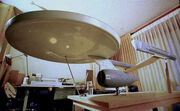
|

|
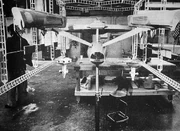
|
Still, upon being contracted the following month for the movie VFX, RA&A made the final decision that the model was too small and not detailed enough to meet big screen requirements, and that a new model had to be built from scratch. Taylor clarified, "Before our involvement, the production had been working up a model of the E. It was about 4ft. [sic.] long. It was made with molds and fiberglass. The model I saw had no lights built into it. Its design I thought was an improvement on the television version. Regardless of its design the level of detail and the scale of a model to be filmed with the latest motion control technique could not be accomplished with that model. We would have to build a new version from scratch. Of course this isn’t what the folks working on the show wanted to hear." (Star Trek: Creating the Enterprise, p. 103) On another occasion Taylor was even more outspoken in his opinions,
"When we first came on the project we had to look at everything that existed and Roddenberry said, "Just use the sets that we’re building and the models we are building". So, I gave the models and honest look but had to tell them in the end that "If you use these models and sets, you’re going to be laughed out of the theatre". The models would have been embarrassing at best. They were really old school in their detail and were not built to armature and light the way we needed for motion control. They looked like the old television show. Again, Don Loos built the Enterprise and Magicam built the dry-dock and a few other things but they were building for a television movie. The resolution of television is forgiving; the big screen is not. I sat down with Roddenberry and Katzenberg and said we are going to have to redesign the Enterprise because it needs to be armatured from six sides and it needs to have lighting systems in it. I told them "You saw Star Wars. You saw the quality of those models and for us to shoot these models of yours with motion control; to put that motion blur in there with multiple passes… it has to have lights that we can control for individual passes". If the camera is going to get close to the model–say, up close to the windows, the model has got to be big enough for us to give it detail. Trying to film a model that is too small is deadly. The focus, lighting, depth of field, surface textures and much more come into play. The Enterprise ended up being almost 12 ft. [sic.] long. The model that was under construction was maybe 4 ft. [sic.] long." [10]
Dow too, considered Loos' work somewhat sub-par, "Don Loos is a very fine model maker, but his techniques were a bit antiquated and his model was made for television." (Starlog, issue 30, p. 27) This however, solicited a response from Loos' employer Price, who felt that his employee was being short-changed by Dow, "Loos is doing a lot of work with us now on various models for NASA and I have the greatest respect for his ability. He does not use "antiquated" techniques as Dow says unless it is for the best." (Starlog, issue 30, p. 8) However, Dow's off-the-cuff remark for Starlog magazine was not meant as nearly as derogative as Price made it out to be as he had explained in an, at the time, unpublished interview where he delved in far more detail into the production reasons for having stated so,
"Bob Abel took a look at the rest of the models we'd been working on–the Klingons, V'ger and the space office complex– and at the Enterprise, which Don Loos had been working on. It was decided to shelve all of the models, because they were definitively built for television, and to bring the Enterprise into our shop. This was because Don Loos unfortunately wasn't equipped, as we were, to build a model for motion-control shooting, which requires many things designed into the model in the way of stability and inter-changeability and interfacing to the computer-controlled rig. He was still doing things in fiberglass and wood and other materials that we don't use because they're much too heavy. Our basic armatures have to be designed in a very solid way in aluminum, and our body skins are designed to cope with a variety of things, thermal changes and so on, so that they don't flex or expand. Also, Bob Abel wanted to work with models that were scaled for one inch equaling 10 feet, and Don's Enterprise was a little under that. And he wasn't constructing models the way they necessarily have to be constructed for the motion-control camera. Models today are a great deal more exotic than they used to be. "For instance, the Enterprise, being a cantilevered object very spindly in nature, must not flex between camera passes. The propulsion pods are suspended on struts away from the main body, and the primary consideration is: from how many points do you armature the model for shooting? And once we'd decided on five for the Enterprise, how do you power the lighting systems from each of those five armaturing positions? How do you keep the model from flexing, or dropping the nose of the saucer, when you turn it on its side? Which lighting systems do you select, based on the kinds of exposures with which you're going to be able to afford to photograph the model? And how many times do you have to expose the model in repeat passes of motion-control photography in order to build up the single image of the model? And so on and so forth. There really are a great deal of things that mist be considered in the basic model design that are never even thought of by people who aren't familiar with motion-control shooting. Well, we were familiar with it, and Bob Abel was planning to build a motion-control camera, so we began the design/construction phase of the models for the Robert Abel version." (Return to Tomorrow - The Filming of Star Trek: The Motion Picture, pp. 62-63)
Price was pulled off the project in January 1978 (though his company would be rehired later to build props for the movie), the model three quarters complete by then, and the task of building a new model reverted back to Magicam. [11](X) Dow's explanation notwithstanding, Price, unsurprisingly, was not amused, "What is not mentioned is that his model was built for less that $10,000, while the movie version is already near a half million [sic.] and climbing! 1 really get upset at the thought that a model should cost that much when it really isn't necessary. Much of the cost went into experimentation and rebuilds." (Starlog, issue 30, p. 8)
By then, it was decided to discard the models made for Phase II, including both the spacedock and the Enterprise models, as was confirmed by Dow (American Cinematographer, January 1980, p. 153) and the painter of the follow-up movie Enterprise model, Paul Olsen, who related, "It also meant the scrapping of four month’s work building models, which Magicam had just completed, so the crew held a wake for the models and trashed them. Lobster was served by Bob Morris (who later opened the famous Gladstone’s Restaurant in Malibu) on the huge 8-foot by 12-foot elevator table with the TV drydock and the original Enterprise hanging over it as a chandelier. Party over, next day start over! Only this time with proper movie models." (Star Trek: Creating the Enterprise, p. 46)
Yet, a Brick Price Enterprise model turned up years later in the Planet Hollywood restaurant in New York City in the early 1990s. The saucer section and torpedo launchers were heavily adjusted to reflect the appearance the refit Enterprise has in the movies. The nacelles, secondary hull and the upper dorsal retained its original Phase II design, resulting in an unfamiliar looking hybrid between the Phase II and the movie's Enterprise. [12] Star Trek aficionado William S. McCullars has showcased pictures of the model, provided by Price himself, on his now defunct website "The Idic Page". At the same time several others were sighted at other Planet Hollywood restaurants which indicated that the franchise contracted Price to make several copies. "The model was built from parts pulled from the phase II molds. A lot of models were duplicated so that they cold be displayed at more than one Planet Hollywood.", John Eaves later confirmed. [13] American collector Adam Schneider [14] provided confirmation of existence of copies (which he had measured at approximating 6-foot in length) as he acquired one and had it converted to approximate the The Motion Picture appearance as a companion piece to the actual drydock studio model he owned. [15] [16] Additional confirmation was provided in the documentary series Hollywood Treasure (season 1, episode 15, "Trek to the Future", broadcast 8 June 2011), in which Price himself presented the molds and partial casts of the model. It could be discerned that some of the molds were at least partially modified and that the castings were not those of the original model, establishing that Price only retained the molds in 1978 and not the original model, despite his assertions to both McCullars and Hollywood Treasures to the contrary.
CGI models[]
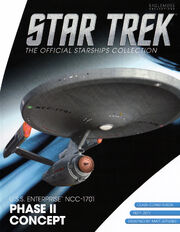
…on the cover of The Official Starships Collection
Daren Dochterman built a Phase II CGI model that was to be used in the fan series production, Star Trek: New Voyages. [17] His model premiered in the 2012 vignette "Going Boldly".
A second, officially franchise licensed CGI model was constructed at the behest of Project Manager Ben Robinson by Ed Giddings for the British partwork publication Star Trek: The Official Starships Collection. [18] Giddings' model made its appearance in, and on, that publication's January 2018 Bonus Issue 06.
As this publication was also a magazine/model combo release, it also marked the occassion that the Phase II design was officially brought back in the physical realm, its display model constructed from Giddings' digital construct. [19]
Designing a refit Enterprise for The Motion Picture[]
Originally Art Director Richard Taylor wanted to totally redesign the Enterprise from scratch, once the movie project, Star Trek: The Motion Picture, became definitive in November 1977, but Roddenberry vetoed that notion and insisted to keep the basic design as established for the Phase II project and instead to concentrate on redesigning the details. (Star Trek: The Magazine Volume 2, Issue 8, p. 85) Bowing to the inevitable, Taylor turned his thought processes to the job at hand, "I got into the philosophy of how the Enterprise theoretically works. The Enterprise behaves somewhat like a surfboard that rides on a continuous wave created by the disturbance in space created by the anti-matter in the nacelles. But again, the Enterprise's center of gravity is outside its actual body, so I put maneuvering thrusters all over the craft, on the nacelles, the saucer, etc. Something I wanted to do was have an animation effect for the thrusters working when the ship is maneuvering out of the dry-dock. I also assumed that at some point we might want the saucer to jettison–either in this film or another one–so we designed it so that the saucer could maneuver by itself and land if necessary. So, the Enterprise had lots of functions it had to accomplish in the movie. How things came in and out of the Cargo Bay and how they were moved and stored." [20] Additionally, in the process explaining why he had originally wanted to completely redesign the ship, Taylor has stated, "I have always thought that the Enterprise is one of the worst designs ever conceived for a spacecraft. The center of gravity of any object in space has everything to do with its shape. The Enterprise by its configuration is one of the most unbalanced objects in the history of space and science fiction. So I asked Roddenberry if I could change the shape of the E. I wanted to create an entirely new design. He emphatically stated that the configuration of the TV model was iconic and that it had to remain the same. But I could modernize it? I studied the original Enterprise models from the television series and then started sketching to create a new version that had some elegance and style. My basic concept was to Art Deco the ships design. Give it a horizontal flow and keep it more like a Frank Lloyd Wright space ship. I wanted to emphasize lines, scale, and detail. The Saucer’s proportions were changed, the Ion engine was added at the rear and other details like landing gear, thrusters and lights so that the saucer could jettison from the rest of the ship and become it’s own flying saucer." (Star Trek: Creating the Enterprise, 1st ed, p. 103)
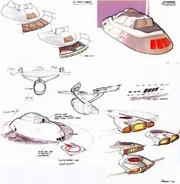
Probert's design evolution of the bridge and impulse engines
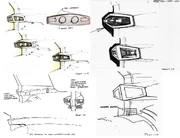
Probert's design evolution of the torpedo launchers
Brought in by Taylor, parts of the new Enterprise were also re-designed by Andrew Probert, based upon Minor's and Jennings's concepts for Phase II. Aside from Taylor and Probert, other artists who also worked on the refit design were Douglas Trumbull and Harold Michelson, staying with the proportions inherited from Jefferies' upgraded Enterprise for Star Trek: Phase II, after the prodding received from Roddenberry. Probert on his assignment:
"When I first got onto Star Trek: The Motion Picture, I was told by my art director, Richard Taylor, that he wanted me to design all the humanoid spacecraft. That way there would be a perceived visual continuity between all the hardware. And then another team would design V'Ger. My designs actually started with the Space Office Complex, but when it came time to design the Enterprise, he requested that I delegate the job of designing the warp engines to him, because he had these ideas that he wanted to put forth about bringing an art deco look to the new Enterprise. He also instigated the look of various sets of parallel lines around the ship to enforce that theme. So while he was doing the engines, I wanted to actually go larger on the size of the ship, not realizing at the time that the Enterprise was originally in drydock for a refitting. Richard felt we should stay with the proportions that we had inherited from Matt Jefferies and Joe Jennings, when they'd designed it for Star Trek: Phase II. So with that as our starting basis. I lengthened the ship to a thousand feet, just a few feet longer than it was, and enlarged the saucer, eventually adding an updated superstructure to the top and bottom of it. I came up with new photon torpedo tubes and redesigned the whole navigational deflector dish area, updated the impulse engine, and added phaser banks around the ship, visible for the first time, along with a reaction control thruster system to the ship – those were there for the first time too, designing them in a way that the ship could operate as two independent entities, being the primary and secondary hulls, or as a combined Starship unit." [21]
Apart from re-designing the warp nacelles, Taylor added the the parallel lines along the saucer's edge and came up with the large transparent botanical windows in the lower half of the engineering hull, "My approach was to give it a stylization that was almost art deco. Things became more elongated and more elegant than the TV series version. I tried to give it a very art deco feel; for example, I added the parallel lines along the edge of the saucer. I spent weeks drawing and redrawing the nacelles. The front end of them is almost a 1940 Ford grill.(…)We used small transparent images of the sets inside the windows so that when the camera got close to the model it appeared that you could see something in the windows. By the way, in some of the windows you can see photos of Mickey Mouse, Andy Probert, and others as a kind of in-joke." (Star Trek: The Magazine Volume 2, Issue 8, pp. 85, 87) In regard to the nacelles, Taylor has added, "The Nacelles were the most difficult part of the design of the Enterprise. I spent more time on their design than any other part of the Enterprise. I felt they needed to be linear and streamlined. I wanted them to look more powerful and complex, like something Nikola Tesla might have designed. Being the engines of the ship they needed an anti-matter effect around them when in warp drive. I wanted them to look like they might be heat exchangers. Finally, I gave them a deco feel and made them much more rectilinear than the cylindrical designs of the television model." (Star Trek: Creating the Enterprise, 1st ed, pp. 103-104)

|

|
A design patent, No. D260789, was issued by the US Patent and Trademark Office to Paramount Pictures for the USS Enterprise on 15 September 1981 (there called a "toy spaceship"), which noted Andrew Probert as the "sole inventor" of the design. The patent extended to both the original configuration as well as the refit-configuration. The patent application was tendered by the studio on 19 March 1979 and, when issued, was valid for fourteen years.
Building the eight-foot refit model[]
Roddenberry vetoing Taylor's radical design proposal, enabled Magicam's Modelshop Supervisor Jim Dow and his crew to start construction on the model in late February 1978. (Starlog, issue 27, p. 29) After drawing up a set of preliminary engineering drawings with the help of Chris Ross, Dow and co. started with constructing a forty pound weighing aluminum framework, designed by Dow himself, for internal strength for the model and as a armature for mounting the finished model for filming. The armature was constructed by Chris Crump, who laid out and assembled the basic 6061 T6 aluminum aircraft grade subframe, and Lee Ettleman who fabricated the pieces in Magicam's machineshop. (Star Trek: Creating the Enterprise, 1st ed, p. 48) Since no story-boards were yet available at the time Dow had the foresight to design the frame with five mounting points for 360 degrees shooting options around its center of gravity (though the top mounting point would be eliminated later in the process). (American Cinematographer, February 1980, pp. 152-155 & 178-180) Plastic vacuum-formed molds (the four foot diameter dish being vacuum formed butyrate over a spun plaster mold) were subsequently applied to the frame to skin the model. Redesigned elements from Taylor and Probert were built and applied as they came in during the construction of the model, making the redesign build a process on the fly. By this time Crumb, had been appointed lead modeler on the build and headed a team that was beefed out with Ross, Chris Elliot, Kris Gregg, Ron Gress, Richard Thompson, Mark Stetson along with Paul Olsen.
Suggested as early in "The Apple" as being able to perform a saucer separation, the model was constructed in such a way that a separation could be filmed if the need arose, though the feature has never been utilized. (Star Trek: The Next Generation Companion (3rd ed., p. 9)) It had actually already been foreseen for the model's direct predecessor, the Phase II model, as related above. On the eight-foot Motion Picture model Probert himself remarked in this regard, "The Enterprise was always designed to separate from the Engineering section. I knew about this when I did Star Trek: The Motion Picture. And if you look at the bottom of Kirk's Enterprise [remark: original configuration], you'll notice two triangular items, which are two of the landing feet for the saucer. Regardless of whether it was Matt Jefferies' original intention or not, it's sort of the way that "Trekdom" or "Star Trek lore" has labeled those features. So taking my cue from that for Star Trek: The Motion Picture, I placed four landing legs in the bottom of the Enterprise and crated a very specific separation line on the dorsal." (Star Trek: The Next Generation USS Enterprise NCC-1701-D Blueprints, booklet, p. 8) The continuous adding of redesigned elements to the model meant that detailed accurate blueprints of the model could only be drawn up by David A. Kimble after the model was finished, though detailed orthographic exterior views were created by Taylor for familiarization purposes, as well as serving as basis for the ships operations graphics seen on the bridge in the feature.
For internal lighting, Dow decided to use neon. Lighting studio models with neon, was a relatively new technique at the time, and Dow decided to hire a specialist, Larry Albright, to apply it. Dow stated,
"Larry Albright and Paul Turner designed the lighting systems for the ship; Larry, the high voltage neon and Paul, the incandescent. Neon was chosen because of the impracticality of the use of fiber optics, due to the armaturing system (five-way) and its ability to throw a great deal of light without the attendant heat, as with incandescents. It was used wherever there was a light source in an inaccessible area and for longevity. The tiny point sources of incandescents were used where needed.(…) "Lighting systems which were made of four-milimeter neon tubing and developed by Larry Albright (56 of them, requiring 3000 volts to illuminate each) originally were to be the major illumination source of the starship. The idea was for the combined models to provide their own illumination, the thought being that lighting would be supplied totally from within the model. Hundreds of incandescents would be used in the structure, these being tiny sources called axial lamps, ten times smaller than a grain of wheat bulb. I am certain that the illumination sources discovered by our electrical people, Albright and Turner, were definitely a breakthrough for our industry. Five and six-volt computer lamps with long life ratings, good quality control for the shape of the glass envelope, and pin-based for replacement, were also built in throughout the structure." (American Cinematographer, February 1980, pp. 178, 186)
Dow further remembered, "Almost all the cabin portholes are neon – neon because the model had to be sealed, and neon has the longest life and generates the least amount of heat. It was next to impossible to provide maintenance ports in the Enterprise because it's such a smooth-skinned object. We didn't have the luxury of all that nerny detail that the Star Wars models had, to hide the lines of panel openings. But now they've added so much skin detail – which I'm sorry to see aesthetically – that we could have done it. Our job would have been much easier: we could have opened it up for access to the lights and wiring." (Starlog, issue 27, October 1979, p. 29) The inaccessibility of the internal wiring bedeviled VFX crews in later movies. Dow and his team finished up on the model in September/October 1978 and delivered it to the producers, coming in at seventy pounds. At Trumbull's insistence however, further detailing and revision of the lighting, meant that work on the model continued in the months that followed.
Mark Stetson has revealed that while the build of the model was in progress, far more detail had been incorporated into the model by Magicam than was eventually revealed on screen, then and thereafter for the most part,
"Also, you saw the photon torpedoes being fired, used to destroy the asteroid in the wormhole, but you never saw those lights come on in the ship, and that's one thing that may be used in a sequel [note: which indeed it was]. They never had a close-up of the photon torpedoes being fired, you just saw it from behind.
"There was a little garden in the fuselage of the ship, which they were hoping to show in the final shot, but they ended up just showing a little bit of the ceiling of that room. It was supposed to be like a holographic projection of sky in a little recreation area where thee crew could go to relax and think that they were maybe on a planet somewhere. So there was a little diorama built into the side of the ship there which would have been nice if it had been shown. I don't think it was ever shot. It was just of those things that didn't correspond with any of the storyboards that had already been laid out.
"There was also a lot of detail up in the saucer that was never revealed. When the ship is in drydock, if you look closely at the bottom of the saucer you can see three open patches. And if the camera had flown up close by them you could have looked deep down inside the ship, and it was just full of detail in there, it was really beautiful." (Return to Tomorrow - The Filming of Star Trek: The Motion Picture, p. 241)
His miniatures not being utilized was something Stetson approached with a philosophical detachment, when he added on the same occassion, "And because of the nature of the project, where you're building something that has to work right the first time, there are a lot more things you can do that come out better in an area that's never seen than in the areas you end up seeing. Some modelmakers feel a frustration about that. I, personally, don't, that's just something that's in the nature of the game. It was drummed out of me early, too; industrial design is much the same way." To date it is yet unknown if Stetson's saucer miniature dioramas were replacables or that they are permanently locked within the model.
Unlike its original television progenitor, the eight-foot model was covered all over with gridlines, which Stetson called "scribe lines" and for which, aside from practical reasons, there was actually an in-universe rationale as well, as he explained, "A scribe line is a fine line applied for graphic or detail reasons to a model. It might be used to indicate a seam between two body panels [note: thereby also camouflaging the removable panels where the armature mounting points were located]. On the Enterprise models, there's a grid of major scribe lines that are quite deep, maybe 20 thousandths of an inch wide – which blown up in scale, would be several inches wide – in a V-groove, to indicate a deflector grid that had been referred to in the original TV series. They'd say, "Deflectors up full," for instance, and they'd turn on the grid to defend the ship from attack or other emergencies." (Return to Tomorrow - The Filming of Star Trek: The Motion Picture, p. 241)
While construction on the model was in progress, Taylor and Dow started to consider what color and hull detailing the Enterprise should have. Taylor reiterated, "One of the things we did with all of the models was to give their surfaces details and interesting designs. A smooth object has no scale so it’s important in model work to find ways of creating scale. Sometimes it’s very subtle but it’s one of the most important elements in model photography. (…) I had this idea of giving the surface of the Enterprise a patterned, plated look and we made masks for the surface to create that surface effect. We did experiments with Crescent Metal Powders and other iridescent and pearlescent paints. So, in the end we made pearlescent body panels that varied from each other by minute differences in color and reflectivity. There were multiple masks that were used to give the surface the complex texture you see on the screen. The painting was phenomenal." [22] Going into more detail in regard to the coloring he added at a later point in time, "As we worked up the Enterprise it became apparent to me that we needed a special paint technique to give the surface of the ship scale. Literally the different spectral qualities of paint and the thickness of one coat of paint could make the surface detail of the Enterprise believable. I had done some tests with different paints as a painter and knew of the Crescent Metal Powder paints and their pearlescent pigments. Jim Dow and I looked into them as he had used them as well on his 1935 Ford, did a little test and decided some combination of those pigments would work. Designing the pattern and doing the actual painting, now that was going to be one hell of a job for someone to tackle…" (Star Trek: Creating the Enterprise, 1st ed, p. 106)
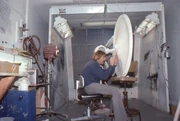
|
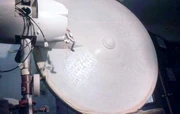
|
At first, Zuzana Swansea was appointed to try to apply the designed surfacing detail for the saucer section, most notably what was to become the "Aztec pattern" (Taylor's interlocking "patterned, plated" hull pattern on the saucer section, a hallmark for later classes of Federation star ships) as was envisioned by Taylor. However neither she, nor Dow or Taylor, possessed the painting skills to apply these details themselves. In order to accomplish this, Dow contracted free-lance airbrush artist Paul Olsen early on to apply the paint job, who has commented, "I was restricted to the dish, as the rest of the model was not finely detailed enough to take paint; the dish was divided into grooved panels which limited me to designing each one, and a Czech girl named Zuzana Swansea had made a tentative start on one of the panels, breaking it up into an Aztec-inspired design which was Richard Taylor’s idea and which I really liked. Zuzana had handed the keys back to Jim because she didn’t possess the airbrush skills to pull off all the varied surface detail." (Star Trek: Creating the Enterprise, 1st ed, p. 48). Working on the model, starting with the dish, for the better part of eight months, the most striking part of his work was the application of a high-gloss pearlescent lacquer coating which gave the Enterprise a chameleon-like appearance in the movie, changing its color appearance depending on the kind and direction of lighting. The "Aztec pattern", for example, was only visible if the light hit the model at an oblique angle ("I used four pearl colors that were transparent: a blue, a gold, a red, and a green… they all flip-flopped to their complements when the viewing angle changed. Beautiful. By varying the amount of color, and the mixture of several colors on top of each other, I obtained myriad colors and depth of color.", Olsen later remembered. [23] Though Olsen has credited Taylor and Swansea for the "Aztec-pattern" design, Andrew Probert too has claimed credit for its creation, "Richard asked me to come up with an overall scheme of surface paneling to give the ship another level of detailing. I agreed that it would give the Enterprise more credibility as a manufactured spacecraft, even though panel lines wouldn't be visible at the scale distance needed to encompass the entire ship in a shot. Richard thought a subtle differencing of the paint scheme would accentuate those panels and that worked really well. For the saucer, I came up with "Aztec Pattern" panels providing a series of interlocking edges in order to reinforce the ship's surface tensile strength." [24]
Late November 1979 Magicam finished up on their part of their assignment of the model build, as worded by Jim Dow, "When she was finished after nine months' gestation, the Enterprise was eight feet long with a four-feet diameter saucer.´ It weight less than 70 pounds, and I like to compare that to the Millennium Falconin Star Wars, which was, about four by four and weighed over 300 pounds. I call that design, design from the ground up. Whereas some of these other models just kind of grow, thew Enterprise was really designed from the ground up.(…)The main Enterprise, we had a ceremony where we hung a bottle of champagne from the drydock as if we were christening the ship, and the I gave Robert Wise the keys to the Enterprise. It was only a symbolic gesture, of course: they were my car keys and right after the ceremony he gave them back to me." (Return to Tomorrow - The Filming of Star Trek: The Motion Picture, pp. 276-277) The model was subsequently turned over to Astra Image Corporation (Astra), the subsidiary of RA&A, located on Seward St, Los Angeles, responsible for RA&A's studio model effects photography. Model painter Olsen followed suit to finish up upon his work.
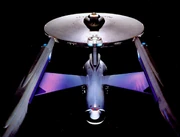
|
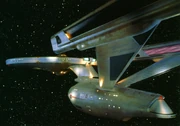
|
While considered magnificent, the paint job caused some trouble for Douglas Trumball in shooting the model. As Olsen remembers on his website, "Dear old Doug drew me aside with one of his big grins and said, "Paul, it's terrific, but we may have problems shooting it because I think we'll get light kicks off the edges of the model." The model was so bright and so colorful that light flare against the black background she would be shot against would make it impossible to isolate the edges of the model from the background so a star field or planet fall or other effect could be photographically dropped (matted) in cleanly. They would have to shoot the model with low light, which would cool the reflections and all the model detail as well. There are still some shots where the opalescence can be seen, but the real thing looked so much better than can be seen in the movie." [25](X) Even more impressed with the paint scheme was Bill George, a novice model maker working at the time for Greg Jein on the various V'ger studio models and who happened to chance upon the model, "Greg's shop was away from the main shooting facility. I was not authorised to be on the shooting stage, but one day while making a delivery there I saw the model of the ST:TMP Enterprise for the first time. For me that was really a magic moment. The Enterprise model was really breathtaking and huge (about 9 feet [sic.] long). It had a polished pearlescent paint job that gave it life and depth that I hadn't seen anywhere else. Its appearance on film muted the magic of the paint job because the naked eye is much more sensitive to subtlety of the colours." (Sci-fi & fantasy modeller, Vol. 26, p. 76) It was not to be George's last encounter with the model. Olsen was assisted by Magicam's Ron Gress, who worked on the secondary hull.
As related elsewhere, the production of The Motion Picture was a troublesome one, fraught with delays and setbacks. The Enterprise model itself also caused some, one of them near completion when, "The Enterprise was just about finished, when one night, after we had all gone home, some clown impressing his girlfriend showed her the model, turned on all the circuits out of sequence and blew the circuits in the dish. This required major surgery and repainting and added two months to the shooting schedule which was now getting hairy.", Olsen remembered. (Star Trek: Creating the Enterprise, 1st ed, p. 55) The second setback occurred just after shooting had started when over the 4th of July weekend, the the air conditioning system went awry and dripped water onto the bridge of the Enterprise, warping it, causing the top half to pop off the dish and take some surface paint with it. Gress and Stetson had to pull an all-nighter to patch it up. Stetson recalled,
"Ron was actually being modest. It was two all nighters in a row for me. It was hot summer in the middle of model photography, and the model had been left in a hot set-up on stage over a rare weekend of not shooting. I am only speculating, but it could have been a holiday weekend – maybe July 4th. The faulty building A/C unit dripped all weekend from the ceiling of the stage right onto the bridge section, which had, believe it or not, been constructed from pattern wood. It warped, curled and cracked loose at the joint with the saucer. A shot had been planned pulling out from a close-up of the bridge, full-screen, so a quick repair was not an option. We pulled the model into our little maintenance shop and I detached the bridge part and started fresh on a new one. I turned a new acrylic pattern on a machinist's lathe for the main bridge dome. I used the precision of the lathe to scribe in all the horizontal detail lines, and then sculpted the rectilinear aft section from polyester body filler, over a styrene and acrylic box structure. Then I made an RTV silicone rubber mold of the pattern and laid up a part using white tooling epoxy and fine fiberglass mat. I didn’t use polyester resin because we were concerned about the dimensional stability of the part being so new and 'green'.
"Meanwhile, Ron masked off the top of the saucer and flattened and filled all the damage at the joint where the bridge had cracked loose. There was a lot of paint build-up on the model by that point, so Ron had to figure out how and where to merge the new work into the original paint layers. Kris Gregg prepared tiny replacement lights for re-installation. Ron did a light prime coat before we re-attached the new bridge to the saucer. We were very concerned about the coarse texture of paint grain because of the severe scrutiny which the upcoming shot would afford the viewer, where any amount of ‘tooth’ to the paint surface would blow the scale. Ron, therefore, mixed his paints really thin and painted with the lightest touch. We had to re-fill the joint between the bridge and the saucer before Ron sprayed the final prime and finish coats. There was a fair amount of 600-grit and 1200-grit sanding involved.
"I personally worked 36 hours straight, then took a four-hour nap at the Marina Marriott across the street in a room that the production kept for just such emergencies, and then worked another 36 hour shift. Ron and Kris Gregg and others on the crew tag-teamed with me to get the ship ready for filming once more as soon as we possibly could. I still have the replacement bridge pattern and mold around the house somewhere." (Star Trek: Creating the Enterprise, 1st ed, pp. 55-56)
The model, including the revisions Trumbull requested, pushing the weight up to 85 pounds, took in total 14 months to complete. Measuring 100×46.5×21 inches, she reportedly was constructed at a cost of US$150,000. (The Making of Star Trek: The Motion Picture, p. 207)
Using the eight-foot refit model[]
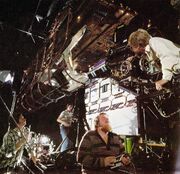
The model within spacedock model set up for filming at FGC
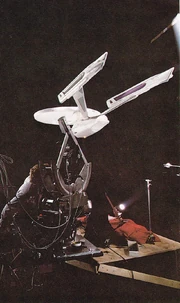
The model mounted at FGC for filming
Trumbull's company, Future General Corporation (FGC), did not use the traditional technique of bluescreen miniature photography. Bluescreen photography had been a widely used technique (already for The Original Series) where a studio model was placed in front of a background screen of a particular color (blue, but green and an intense kind of orange had also been used), using a type of film that did not register that particular color. Anything of that shade of color did not show up on the film, leaving clear areas into which other film elements could be inserted later in post-production. Unfortunately, any reflection of the screen onto the model would also vanish, resulting in holes in the footage of the model, an effect known as "blue-spill", made worse the more reflective the model is. Any holes in the footage in objects that were supposed to be solid had to be painstakingly matted in frame by frame in post-production. By using a technique called "frontlight-backlight", Trumbull managed to work around the problem. "(…) We shot all the Enterprise footage because the Enterprise had a white, shiny surface and would have caused tremendous matting problems at Apogee. Spill light from the blue screen would have reflected off the ship and created holes in the mattes. Even with our high-con operation we had quite a problem pulling decent mattes off that model: with blue screen it would have been nearly impossible." (Cinefex, issue 1, 1980, pp. 12-14) Trumbull also had the internal lighting rewired to satisfy his vision of a concept of self-illumination as opposed to a model completely awash in light as it was originally constructed. For highlighting several spots on the model, FGC employed a visual trick as was explained by Olsen, "One nifty trick the lighting guys employed which impressed me was in order to dramatically light the Enterprise, they placed big styrofoam blocks about the model with lots of dental-type mirrors of various diameters on swivels. The were stuck in the foam, a spotlight was shone on them, and the lighting whizzes then pointed each mirror to the part of the ship they wanted to light. Some mirrors had colored gels on them, others Vaseline to blur the edges of the light, and the whole effect was perfect. Such a simple trick, but ever so effective." (Star Trek: Creating the Enterprise, 1st ed, pp. 56-57)
Though FGC filmed the model, responsibility for it fell to FGC's subsidiary company, Entertainment Effects Group (EEG), in order to cover legal liability if anything untoward were to happen to the model. For this purpose a number of model makers, among others Mark Stetson, moved over from Magicam to EEG as model handlers, to make sure the model was handled properly. (Star Trek: Creating the Enterprise, 1st ed, p. 180)
The Wrath of Khan through The Voyage Home[]
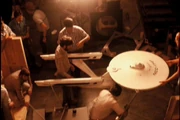
ILM's visual effects team struggling with the model during uncrating
Dow and his team made the model a rugged one, suspecting the model would be used in in subsequent outings. His foresight was fortuitous since it became apparent that The Motion Picture would have follow-ups. The model, being constructed out of molded plastics instead of the heavier fiberglass traditionally used until that time, was considered light at the time. By 1981 however that view was not shared by the VFX team of Industrial Light & Magic (ILM), which was handed over the model for pre-production of Star Trek II: The Wrath of Khan. Although admired, the model was soon loathed by the team for its cumbersome handling and heavy weight. Director of photography Kenneth Ralston had been on record for his open dislike of the model at the time, "I hate that model. I think it's made out of lead. I don't know what's inside to make it so heavy; it took eight guys to mount it for a shot and a forklift to move it around. (…) I'll probably get attacked about his, but I'm just not crazy about the original design of the Enterprise. It's a shape that does not lend itself easily to looking good in the frame. It's hard to come up with angles that read like anything. There are only two good angles on it." (Cinefantastique, issue 44, Vol. 12, issue 5/6, pp. 54-55) and, "I hate that ship. I've said it a hundred times, but it's true. I think it's ugly – the most silly looking thing. The model is murder to work with, so I'm glad it's gone," he recalled while preparing the Enterprise for destruction in Star Trek III: The Search for Spock. (American Cinematographer, August/September 1984, p. 61) The cumbersomeness was one of two reasons why the class of the USS Reliant was redesigned from a Constitution II-class – as it was originally envisioned in an early draft of the script – to the Miranda-class, the other reason being that the producers were afraid that audiences would not be able to tell the two ships apart during the battle sequences. (Star Trek: The Magazine Volume 3, Issue 5, p. 83)
Further problems arose with the internal wiring for lighting when some of the lighting shorted out. Unable to procure help from the original electricians from Trumbull's company FGC (FGC also tendered a bid to do the VFX for the movie, but was passed over in favor of ILM), Marty Brenneis, responsible at ILM for all the electronics and supervising model maker Steve Gawley had to figure out for themselves how to fix the problem. As Brenneis recalled, "The lighting in it was obviously done by a model maker who knew nothing about electricity. I and a couple of the model makers had to do some rewiring to least make it safe! It was too much work to completely rewire it, but we patched the bits that really were hazardous so that we could use it. Another complication was that all the lights were sealed inside the ship, so if even one was damaged the entire model would have to be taken apart." (Star Trek: The Magazine Volume 3, Issue 3, p. 20) Brenneis' comment was vividly illustrated by an instant when some of the lights were knocked out due to a shorted wire, bringing filming to a halt. Gawley had to go into the model, arm-pit deep, to feel out the loose wire on touch. An added disadvantage of the complicated and cumbersome wiring was that Ralston had to painstakingly, and thus time-consuming, rewire an elaborate network of switches on the Enterprise to a big control console every time the model was mounted for filming. (Cinefantastique, issue 44, Vol 12 #5/6, p. 55)
Trumbull's concept of self-illumination caused Ralston yet another set of headaches in filming the exterior lighting of the model. That concept meant that in the previous movie certain surface features were pointed up, such as the registry number, the name and the Starfleet logos. Trumbull had achieved this among others by using an elaborate set-up with adjustable tiny mirrors that reflected the studio light onto the model, acting as miniature spotlights. ILM used a rig with with actual tiny spotlights with adjustable lenses, so light spots could be reduced to pinpoints. Ralston found it excruciatingly hard to incorporate this feature during filming however, as whenever the model rolled all these tiny spots of light had to roll with it. Since it was infeasible to have the lighting rig to roll, Ralston had to use tricks shots, like having the cameras roll while the model was stationary, to achieve the effect, "It affected the flexibility of what we could do with models. Fortunately they're not doing maneuvers like X-wing fighters anyway. They sort of lumber along, and it's what's going on all around them that creates the excitement in scenes like the grand-slam finale: the battle inside a nebula." (Cinefantastique, issue 44, Vol 12 #5/6, p. 57)
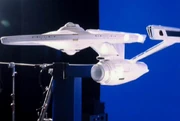
The toned down model on set for blue-screen filming at ILM
Using the blue-screen miniature photography technique, Ralston soon encountered the same problems Trumbull had with the intricate paint job while shooting. Because of budget restraints not being able to change filming techniques a decision was made to give the model its first repaint. Highlighting details with matte paint on the hull and using dulling spray, the team got rid of the pearlescent gloss of the model. Justifying the decision Ralston said, "The ship won't look any different on the screen. The iridescense effect still works, but having a little relief on the surface made things easier for us. We didn't have to horse around with the lighting to get rid of the gloss." (Cinefantastique, issue 44, Vol 12 #5/6, p. 55) The task of dulling down the model befell to newly hired model maker Bill George. For him however, it was a heart-wrenching assignment as it concerned the same George who was so much enthralled with the model three years earlier, "I'm sad to say that a few years later one of my first jobs at Industrial Light & Magic was to spray that Enterprise model from stem to stern with a dulling spray to make it possible to shoot the ship using the blue screen process." (Sci-fi & fantasy modeller, Vol. 26, p. 76) Years later, VFX Camera Man Scott Farrar, almost apologetically, explained further, "The Enterprise, by that time, tying it back into the fancy paint job it had gotten on Star Trek: The Motion Picture, once it got to ILM, I hate to tell the those paint guys in LA, but we basically sprayed it all down so it was matte finish, and if there was sheen on it, I had all these colors of chalk, where I would put chalk colors on the side of the ship so it wouldn't have gleam, because otherwise you'd get the blue screen reflecting on it. It contaminates it. And you get holes in the mattes. You don't want holes in the mattes." (Star Trek III: The Search for Spock (Blu-ray)-special feature, "Industrial Light & Magic: The Visual Effects of Star Trek") Yet, since stock footage of The Motion Picture was also used in the movie, the Enterprise appeared in The Wrath of Khan in both liveries.
As to underscore Ralston's objections to the model, its size also caused some additional problems. Ralston continued to explain how for several fly-by shots the camera had to be turned sideways and lifted up to keep the blue screen behind the model. When using a wide angle lens for close-ups, the ship sometimes ran off the edge of the screen and the stage or ceiling joints showed up on the footage shot.
The master model was virtually used back to back for its next appearance, Star Trek III: The Search for Spock, and needed no further modifications aside from additional application of battle damage, both in the form of paint and rubber patches, molded and painted to simulate battle damage. Aluminum slivers were also applied to simulate peeled back hull plating.
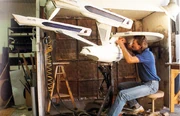
ILM's Eric Christensen working on the wiring of the model
After the third movie, the continuation of the movie series was henceforth by no means an automatic certainty, let alone the reappearance of the Enterprise model, so the model was not cleaned up and put away in storage. By the time Star Trek IV: The Voyage Home went into production and it became obvious that Kirk's new command would be a new Constitution II-class ship, ILM's model shop had to do a major refurbishment of the model, to make it appear as a new ship. By now the the damage add-ons had adhered to the paint and removing them caused damage to the paint, so a first true re-paint was necessary (though the original paint layer was not removed). The decals were also replaced to signify the new call sign "NCC-1701-A". Concerns existed about the internal lighting system, but it held up. It was in this finish that the model was originally slated to represent the USS Stargazer in the "The Battle" episode, before a last minute decision was made to introduce a new ship class.
Star Trek Adventure and The Final Frontier[]
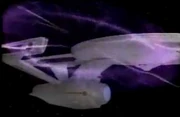
The model on side-assignment for Universal Studios
Another unexpected refurbishment was necessary in early 1989, when the model was uncrated at the New York-based effects house Associates & Ferren. Fully expecting to be able to shoot the model at once for Star Trek V: The Final Frontier, Bran Ferren was dismayed when he observed that, "One entire side of the Enterprise model was sprayed matte gray, destroying the meticulous original paint job. We had to go in and fix it before we could shoot it, which took two painters and an assistant about six weeks to do." David V. Mei was the lead modeler responsible for the refurbishment which also included replacing the decals that were crumbling. (American Cinematographer, July 1989, p. 83) Reportedly, the matte paint was applied in the spring of 1988 by an effects staffer of Universal Studios when the model was on loan to shoot additional effects sequences for their Star Trek Adventure-attraction video presentation, in order to work around the blue-spill problem. [26]
Senior Modelmaker Mei on his contribution, "The Enterprise was built by Magicam for the first feature. Over the years, parts of it had been given battle damage and it needed to be brought back up to standards. One side was essentially undamaged and we had to match that. The Enterprise had always had an iridescent finish that made it difficult to shoot bluescreen. Everybody who photographed it had to solve that problem individually. The artist who originally painted it was Ron Gress [sic]. He used a lot of auto body lacquers and it took him months to paint that thing. It shows. There was so much work on it. I spoke with him on the phone, trying to get some tips. We wanted to remain true to his work." (Cinefex, issue 42, p. 52)
This time around, the internal lighting did not work properly either. "Also, the Enterprise turned out to be an electrical challenge that only continued to work because there were sufficient short circuits within it to keep it arcing into operation – so we had to rewire it", Ferren continued. (American Cinematographer, July 1989, p. 83) The refurbishment was a serious set-back on an already very tight, budget, and shooting schedule.
Final production use: The Undiscovered Country[]
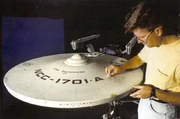
George applying battle damage onto the model
Two years later, the model was hauled out of storage once again for preparation for Star Trek VI: The Undiscovered Country and sent over to ILM's model shop. Lengthy financial negotiations delayed start-up of production, but ILM made use of the time offered them to give the models sent to them a thorough overhaul. Although pleasantly surprised about the overall shape the model was in after more than a decade, the first thing art director Bill George and his team of modelers tackled head-on was the ever re-occurring headache, internal wiring. Not that they had a choice though as ILM modeler John Goodson explained:
"A lot of times you'll inherit a model that doesn't come with a power supply, so somebody has to go through all the wiring and figure out what the voltages are and how everything works. Every model has a bunch of wires that come out out of it off-camera and which basically make the model work – running all the neon running lights and cooling fans. When we got the Enterprise back for VI, for some reason all the power cables had been hacked off! So we had this model that was more than a decade old and everything was sealed inside without the access panels ILM usually builds into its own models. So Jon Foreman, our electronics guy, had to sit down with the end of the umbilicals, with stubs of like fifty wires that go to things in the ship, and figure out what every one of those lights was and rewire the whole thing." (Industrial Light & Magic: Into the Digital Realm pp. 57-58)
Actually, there had been another reason as well for embarking on the elaborate restoration as, while Ferren was aghast over the changes made to the model, it turned out that his VFX people had not been above altering the model themselves, as Goodson revealed on a later occasion,
"We didn't do Star Trek V. So there was a gap. But we received the models to do VI. And they showed up. And the Enterprise was in a big crate. And we pulled it open. And that was a beautiful model. It was about eight feet long. It had a gorgeous paint job. It was a showstopper. That was one of the most beautiful ships that we've ever worked with. But we opened up the crate, and much to our dismay, two things had happened. One, the wiring umbilical, which was about two inches in diameter, solid, with all the various wiring that went into the internal neons, the blinking lights, all the internal electronic stuff, had just been hacked off right at the side of the ship. So there was that. And then the other thing was, the entire bottom of the saucer had been spray-painted flat white. So all that beautiful paint had just been obliterated [note: though ILM themselves used dulling sprays, these only added a transparent layer to tone down the gleam of the original paint job, and did not replace it]. Both of these things were really problematic and really time-consuming to correct." (Star Trek III: The Search for Spock (Blu-ray)-special feature, "Industrial Light & Magic: The Visual Effects of Star Trek")
This time the model was opened up and the wiring was repaired and modernized. "The original powerbus was situated in such a way that about a dozen small wires had to be snaked individually through the different access ports. Jon Foreman went in and rewired the Enterprise with two specific goals in mind: one, make it easier to mount by having a single harness to route through and connect up: two, since we wanted to cut down the number of passes required for each shot, the exposures for the various lights on the ship had to be much closer in intensity. Prior to this, the running lights, window lights and sensor dome had been shot with separate passes. But by reworking the wiring, these could now be recorded in a single pass, thus reducing stage time.", George recollected. (Cinefex, issue 49, p. 42) Also the model began to show its age, now being covered with hairline cracks, damaging the paint layer and also Olsen's original pearlescent paint scheme starting to reassert itself yet again on those parts of the model not "obliterated" by Universal and Ferren. The cracks were filled with putty and sanded down, a new paint layer was applied by Kim Smith together with layers of dulling spray.
This proved to be the last time the model was to be used as a shooting model for a Star Trek production.
Post-production use[]
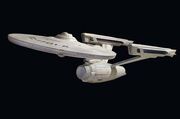
The model at auction
Shortly after wrapping up the production for The Undiscovered Country, the model went on tour, firstly to the 1992-1993 Star Trek Smithsonian Exhibit and a year later to the Hayden Planetarium for its 1993-1994 New York City leg, in both instances shortly reunited with its progenitor. [27] In 2001, the model was sent over to Foundation Imaging as a reference guide for modelers Robert Bonchune and Lee Stringer for their CGI model they were building for 2001's Star Trek: The Motion Picture (The Director's Edition). In awe, Foundation's Digital Effects Supervisor Adam Lebowitz recalled having the model there, "October [remark: the October spread of the Star Trek: Ships of the Line (2002) calendar] is based on an actual photograph I took of the filming model of the USS Enterprise NCC-1701. While working on the Director's Edition DVD of Star Trek: The Motion Picture, the model was on hand at Foundation Imaging, and many of us took the opportunity to grab some photos of living STAR TREK history. On one occasion I rolled out a high-powered film light and placed it at an extreme angle, hoping to catch some dramatic shots of the model. I fell in love with one particular angle that highlighted the way various curves intersected at a central point, and we decided to recreate this with our CG model for the calendar." (Star Trek: The Magazine Volume 2, Issue 9, p. 104)
On 1 November 2001, before being auctioned off in 2006, the model was on its last public display, prominently featured in the banquet hall, mounted on one of the buffet tables, of the Paramount Theatre of the Arts for the Star Trek: The Motion Picture - The Director's Edition DVD Premiere Event [28], where the revamped movie was premiered. [29](X)
This model, known as Lot 1000, the very last item of the 40 Years of Star Trek: The Collection auction, and estimated at US$15,000-$25,000, was eventually sold on 7 October 2006 with a winning bid of US$240,000 (US$248,800 including buyer's premium), which incidentally meant that the studio recouped roughly half the (inflation adjusted) cost it incurred when the model was built back in 1978, a more than reasonable return of investment for a written-off production asset. The model was featured in the documentary Star Trek: Beyond the Final Frontier, as the Okuda's uncrated the model.
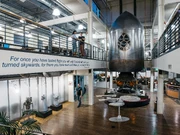
The model at its current Blue Origin lobby resting place
Though having dropped out of sight for some time afterwards, it was a decade later uncovered that the model had been acquired by Amazon.com co-founder Jeff Bezos who had it in March 2016 prominently displayed in office lobby of his spaceflight company Blue Origin, headquartered in Kent, Washington State, when the new office premises were opened. [30] Reportedly, Bezos a known "Trekkie" and science fiction memorabilia collector, has, unlike other renowned collector Adam Schneider, chosen not to restore the model and leave it as he had acquired it, preferring the model to show the wear and tear it had incurred over the course of its career as a studio model. A plaque included at the bottom of its stand simply lists the films it has appeared in, and while prominently displayed, visitors are not allowed to take pictures of the model. [31] [32] [33]
Partial physical refit models[]
On several occasions, even the large eight-feet model was not deemed detailed enough for envisioned close-up shots and enlarged partial models had to be constructed to obtain the desired visual effects. As Richard Taylor had put it, "Different scale models were made for different shots. Some shots of the Enterprise were larger scale models sections of the model that needed even more detail. The side of the E where the shuttle docked was one such model." (Star Trek: Creating the Enterprise, 1st ed, p. 105)
The Motion Picture secondary hull section models[]
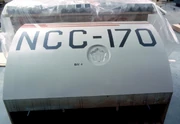
|
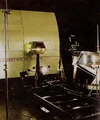
|
The model Taylor was referring to, was an enlarged section of the port forward secondary hull, just below the Starfleet pennant that featured an airlock. The model was deemed necessary as it was there that the travel pod, carrying Admiral Kirk and Montgomery Scott, after their inspection tour was to dock with the ship. As this scene was already envisioned in a later, revised version of the pilot episode "In Thy Image" for the Star Trek: Phase II project, it was one of the earlier models built at Magicam. A memo of Post-production Supervisor Paul Rabwin dated October 14, specified that Magicam agreed to immediately start construction on what was referred to as the "Loading Dock section", after specifications from re-designer Matt Jefferies were received. (Star Trek Phase II: The Lost Series, p. 51) When built, the model therefore initially bore markings and detailing that was in line with the Enterprise model built for that project.
However, it too was inspected on 1 December 1977, after the Phase II project was upgraded to a major motion picture project, and at first it was deemed salvageable as indicated in a five days later memo from Rabwin to Producer Robert Goodwin, which stated, "DOCKING BAY (SIDE OF ENTERPRISE): Add lights to it…either visual contact points, or sensor lights to "tractor beam" onto pod and guide it in. Maybe a signal system…also paint "different colored metals" for the loading dock." (Star Trek Phase II: The Lost Series, p. 72) Yet, as design and construction of the new refit-Enterprise model progressed, it became apparent that the model would not do and it was subsequently discarded as well, replaced with a larger scaled one that corresponded with the new studio model as built, including a re-sculpted airlock and changed signage.
Magicam shop supervisor James Dow recalled, "Among the last models [we built] were a number of miscellaneous pieces, such as a blowup section of the side of the Enterprise, a blowup of the space office complex, a blowup of one of the office pods, and the cargo carrier for the work bee. The last model was the drydock. We built a large-scale, two-inches-to-a-foot section of the Enterprise for the docking sequence where Kirk tranfers from the travel pod to the Enterprise. This side section of the Enterprise was not a major model, it was only used on the screen for a few seconds, but it was large scale – 16 feet long, I think, and 10 feet high – and it took us a month to construct." (Return to Tomorrow - The Filming of Star Trek: The Motion Picture, p. 290) This model was ultimately filmed by FGC for the intended sequence with the matching travel pod model.
The Wrath of Khan section model[]
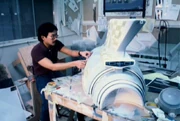
|
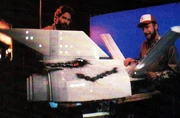
|
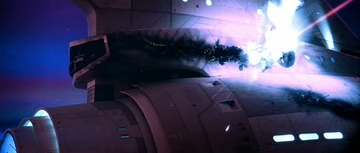
| |
Although Trumbull liked the model of the Enterprise he initially considered the model too small for his purposes, or as he stated it, "the Enterprise in particular, was one-fourth a big as it should have been. Even in Silent Running, which was a low budget movie, our space craft was twenty-six feet long; In 2001, the Discovery spacecraft was fifty-four feet long. But in Star Trek, the Enterprise is barely seven feet long; and it was just an enormous struggle to get not only a sufficient degree of detail, but also camera angles and depth of field and lighting that worked." (Cinefex, issue 1, 1980, p. 15)
Kenneth Ralston came to agree with Trumbull, when it came to shooting the scene where the Enterprise is hit by Reliant's phaser volley in Star Trek II: The Wrath of Khan. In order to get the detailed close-ups (and in order not to have the master model damaged), Gawley and his team build an enlarged section of the forward upper secondary hull with the dorsal. The model, measuring 48×24×27 inches, was constructed out of wood and skinned in wax so that simulated damage could be easily sculpted and animated onto the surface, helped by the fact that the studio lighting softened up the wax. The damage on the model could also be easily reversed if the need arose, as it eventually would in The Search for Spock, The Final Frontier, and The Undiscovered Country, the three other movies the section model would be used in.
The section model, known as Lot 992, being part of the 40 Years of Star Trek: The Collection auction, estimated at US$1,000-$1,500, was eventually sold on 7 October 2006 with a winning bid of US$9,500 (US$11,400 including buyer's premium) to American collector Adam Schneider. [34]
The Search for Spock bridge and saucer section models[]
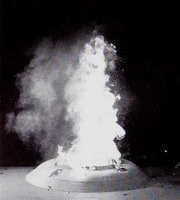
On-stage destruction of the enlarged bridge model
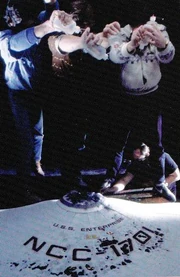
Gawley's team dissolving the enlarged saucer section studio model
For The Search for Spock, the intricate self-destruct sequence required additional enlarged sections of the Enterprise model, a close-up model of the bridge and two close-up models of the upper saucer section. As Ralston recalled:
"(…)my involvement began at the top of the bridge when you see it blowing up. It was a miniature that we shot with the Bruce Hill camera. Sean Casey had done a lot of the work on all those models, mold-making and things, because we had to do a lot of tests before we ever got to really shooting it. The pyro work was headed up by Ted Moehnke, who did a great job on the show. I think we got some nice pyrotechnics and different pyrotechnics, too. So it was a full miniature blown up. Then we had to pull a matte of that put some stars in because it was just shot against black. Then we cut back to the Bird of Prey ship moving away from the Enterprise and dropping down. The top is blowing up. What we did–Don Dow shot that one–we just painted out the top with black. If it's against the stars, you won't be able to see it… We painted it real black. We weren't about to destroy that $150,000 model that Doug Trumball [sic] built. I was tempted though-tempted many times to take a mallet to it.
"Anyway, we had a projector and we were projecting the explosion going off on top of the ship. What you are seeing isn't the ship moving. The camera system is doing all those moves with the ship and all the different light passes. Then we come back and shut off all the lights. We project the the explosions on the ship and repeat the same moves with explosions going off. It looks like it's all locked into the same element. We also put light effects on top of the ship.
"Next we cut to the famous number (NCC 1701) being eaten away and the explosions going off. Bill George devised a very light styrofoam that he laid over this incredible grid work-something he came up with in 20 minutes or so. It looked great. We dripped acetone or MEK or something really vile stuff on the surface, but you can't see the stuff dripping on it. I wasn't sure it would work. The camera is shooting over a frame a second, that is why it is hard to see the drip. We had to get all the light off it, too, or you would see a light coming down. The grid work was shot separately from the surface. It was all put together later so we could do light effects. And some of the explosions were just Ken Smith, the optical photography supervisor, burning out certain frames.
"Then the ship comes right up to camera and the whole dish blows off. Again, the ship was shot using all the same techniques-projection on the surface, etc. But the final explosion, when the whole thing goes, is a large dish shape which Sean made out of plaster. I sprinkled talcum powder over it to get more fine material coming off it. It had several explosives inside that Ted had come up with. And we shot it as high speed as we could, It still wasn't as slow as I wanted it. The explosion was supered over the ship. There is also a stock explosion from The Empire Strikes Back in there too. It comes out from underneath the dish to make the explosion seem a little more cohesive and not so much of an effect." (American Cinematographer, August/September 1984, p. 61)
The Undiscovered Country saucer section model[]
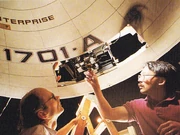
Stromquist (l) and Tan working on the saucer model
For the scene in The Undiscovered Country, where the primary hull of the Enterprise-A is pierced by a torpedo, an enlarged eight-foot saucer section was built at ILM. "When Scott and I were in the very early design phases, trying to come up with ideas to make the battle a little bit different, he asked me, "What have you always wanted to see happen to the Enterprise?" and I my answer was, "I've always wanted to see a photon torpedo go right through the ship. There's one place on the primary hull where it's really thin." We designed that shot and they accepted it. We wanted to make sure that it didn't look as much like a explosion as a shotgun blast, because the photon torpedo's actually pushing through the ship. We built a huge eight-feet diameter dish with replaceable breakaway section made very of very fragile plaster, then hung the model upside-down. On the side away from the camera were fingers of metal that were dressed as the damaged ship. When a pin was pulled, a spring pushed them right through the plaster skin, which cracked since it's supposed to be ceramic tile.", Bill George further recalled. (American Cinematographer, January 1992, p. 61)
Bill George's model making team on the specialty model, was further beefed out with model makers Eben Stromquist and Larry Tan.
Smaller scaled Constitution II-class physical models[]
While the master filming model was used to provide the majority of shots, there were instances were the master model would not do and stand-ins had to be utilized. Like its illustrious predecessor, the original Constitution-class model, the refit model had smaller sized equivalents for forced perspective, and other purposes.
Magicam's smaller scaled Constitution II-class filming model[]

|

|
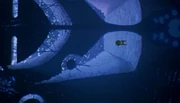
|
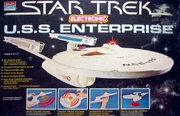
|
"There is also a second model of the Enterprise which is twenty inches long [eighteen according to Olsen], used for long shots," Sackett/Roddenberry claimed in their book The Making of Star Trek: The Motion Picture (p. 207). Built specifically for forced perspective shots, construction on this model was started a few months into the build of its larger sister at Magicam where it was sighted by Paul Olsen when he was hired for the painting of the larger model. (Star Trek: Creating the Enterprise, p. 45)
Jim Dow, confirming their claim, elaborated, "We also built a quarter-scale Enterprise, which worked out to be about 22 inches. It was designed to be used in long shots with V'Ger, but I don't really know exactly where it can be seen in the picture. The quarter-size Enterprise model had all of the same lighting functions that the large-scale model had, it reproduced everything the big one could do, it even had the five-way armature in it. We were able to power all the lighting systems from any one of those five positions in that little 22-inch model. We had to import axial lamps from Japan, which are so tiny they're incredible–they're about the size of a ballpoint pen tip–because everything was scaled down. They're very difficult to get, we had to have them flown in specially for Star Trek. The model itself probably weighed less than two pounds." While Dow did not exactly knew what the small filming model was used for, Mark Stetson did, "The smaller Enterprise miniature was delivered by Magicam to Astra, but it wasn't used 'til much later, by Apogee. After they finished with it, it was again returned to Maxella and used for some final shots there. But the only time you ever saw the smaller Enterprise was in some shots flying over V'Ger where V'Ger fills the screen and you see the Enterprise as a tiny little dot flying across it." It is the model Apogee's John Dykstra referred to as the "one-foot" model, used for the approach and passage of the Enterprise over V'Ger, to emphasize the size of V'Ger, itself an eighty-six feet long studio model, "But for some of the more distant shots we built and photographed a smaller version of the Enterprise, about a foot long." (Return to Tomorrow - The Filming of Star Trek: The Motion Picture, pp. 276-277, 462; Cinefex, issue 2, 1980, p. 67)
The small filming model turned out to be more influential that its rather limited actual use in the movie led to believe, as Dow further attested to, "That model is the one from which we produced a set of molds that we took to Milton Bradley. They have since produced a toy that's on the market which was actually produced from the original molds made for the quarter-scaled Enterprise in the movie. Very few people know about that." (Return to Tomorrow - The Filming of Star Trek: The Motion Picture, p. 277) That production-used model has therefore been, in effect, the very first template for an electronic Star Trek-based electronic starship toy model.
Though returned from Apogee to EEG for additional filming, not a single further sighting of that particular model has been reported ever since.
ILM's smaller scaled refit-Constitution II-class filming model[]
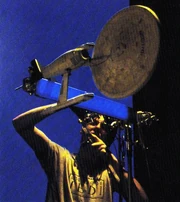
|
 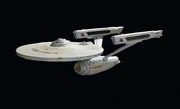
|
The fate of Magicam's small filming model notwithstanding, it was certain that the model was never used again, since ILM, apparently unaware of its existence, built a new smaller Enterprise model for Star Trek II: The Wrath of Khan, using a by then available AMT/Ertl-model kit, number S970. "In fact we used one of the AMT kits to build this little model of the Enterprise, which has about a twelve inch diameter dome. We actually put lights in it and used it in instances where we had to be far away from the ship. With the big model, you can't get too far away and make it look far away – it always looks big. So we used that one for anything where we wanted the ship real small," Don Dow (brother of Magicam's Jim Dow) remembers. (Cinefex, issue 18, 1984, p. 63) Intricately detailed and lit by ILM, measuring 22 inches in length, the model saw use from Star Trek II: The Wrath of Khan through Star Trek VI: The Undiscovered Country, with the exception of Star Trek IV: The Voyage Home.
This model, being part of the 40 Years of Star Trek: The Collection auction as Lot 999 , estimated at US$15,000-$20,000, was sold on October 7, 2006 with a winning bid of US$40,000 ($48,000 including buyer's premium). In a run up to the auction, the model was on tour at the Creation Convention in Las Vegas from 17 August to 20 August 2006. [35](X)
Battle-damaged refit model[]
| The USS Enterprise wreck model | ||
|---|---|---|

|
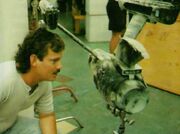
|

|

|
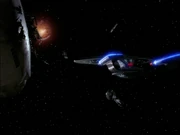
|
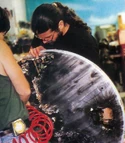
|
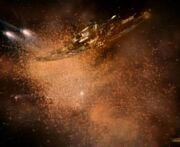
|

|
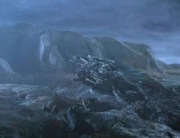
|

|

|
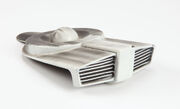
|
For the intricate destruction sequence (the moment the Enterprise streaks across the atmosphere of the Genesis Planet), at the time still done by physical models, in Star Trek III: The Search for Spock, an additional model was needed apart from the already available models and the enlarged physical model-sections. "Neither of these models however, was used for the Enterprise's final destruction sequence. For the shots involving miniature pyrotechnics, Ted Moehnke and his crew worked primarily with partial models that were quickly destroyed-though supervising model maker Steve Gawley and his crew actually constructed a complete model, fully one-third smaller than the original, for full shots of the partially destroyed ship.", Don Dow further remembered. (Cinefex, issue 18, 1984, p. 63) Afterwards, in the mid-1980s, the wreck model made a few appearances in the Star Trek convention circuit. [36](X)
Its use as a destroyed starship was not be limited to this movie, however. The saucer section disassembled (making use of the way the model was constructed to perform a saucer separation, a feature copied from its large sister) from the engineering section and both, refurbished, found their way into the Battle of Wolf 359 aftermath debris field in the Next Generation season four episode "The Best of Both Worlds, Part II". (Star Trek III: The Search for Spock (Special Edition) DVD, "text commentary"; [37]) Visual Effects Coordinator Gary Hutzel, oversaw the refurbishment of the model for its reuse. (Cinefantastique, Vol.28, No.4/5, p. 64)
In a second re-use, modifications were performed on parts of the model, as the saucer section and the battle-damaged Miranda-class nacelle were to be used to represent debris flying off the exploding USS Odyssey in Deep Space Nine's second season episode "The Jem'Hadar". Modifications on the detached saucer-section were performed by Dennis Hoerter and Glenn Neufeld. (Cinefantastique, Vol. 25/26, issue 1, p. 109)
A third and final re-use occurred in the Deep Space Nine sixth season episode "The Sound of Her Voice", where the saucer section appeared, again together with the Miranda-class nacelle, representing the crashed USS Olympia. The surface on which the crashed ship rested, was a landscape maquette constructed by Greg Jein. [38](X) The repainting of the originally, entirely blackened exposed interior was almost certainly done for this episode in order to increase the contrast for the shot. The motion control photography for all three television episodes re-uses, was done at Image G.
This model, at the time re-assembled and known as Lot 993, part of the 40 Years of Star Trek: The Collection auction, estimated at US$6,000-$8,000, was eventually sold on 7 October 2006 with a winning bid of US$40,000 (US$48,000 including buyer's premium). The model, in its disassembled state, was featured in the documentary Star Trek: Beyond the Final Frontier, as the Okudas uncrated the model.
When the model was disassembled for "Best of Both Worlds", the part representing the impulse drive/deflector crystal assembly was removed in order to gain access to the bolts that connected the saucer section to the secondary hull. The piece was either misplaced or lost, since it was not re-attached to the model when it went on sale in the 2006 Christie's auction. However, the piece, measuring 9 × 5 inches, resurfaced in 2010, as it was offered as lot 1268, estimated at US$400-$600 and sold for US$950 to American collector Eric Gunzinger in the June 12 Profiles in History Hollywood Auction 40, misrepresented as "this prop could possibly be the only surviving piece of that special effects model". [39](X)
Display models[]
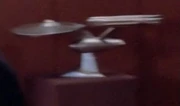
|
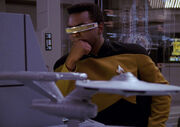
|
A second AMT-model kit, most likely number 6675 or 6693, was in modified form used in Star Trek: The Next Generation. For the episode "The Battle", the producers originally intended the USS Stargazer to be of the Constitution II class, in order to be able to use the existing filming model. In the build-up to the episode the Constellation-class "NCC-7100" desktop model – itself actually mostly constructed with parts from the refit-Enterprise model kit (see: below) – in Picard's ready room was replaced with the AMT model kit to accommodate the transition. When the decision was made very late in the production to have a full fledged Constellation-class studio model built after all, principal photography was already finished and the model remained visible for a couple of episodes in Picard's ready room, since the "NCC-7100" subsequently resided in Greg Jein's model shop as reference for the larger model and would not be returned until later in the season. The model therefore, made subsequent season one appearances in "Hide And Q", "The Big Goodbye" and "Too Short A Season" in its last appearance, and was previously also seen in Riker's quarters in "Lonely Among Us" and "Haven". That model, painted in an overall reflective silver color, was actually built by Rod Roddenberry as a present for his father. It was one of the model kits that had been sent to Gene Roddenberry by the manufacturer. (The Toys That Made Us)
A third model kit, likewise painted in an overall silver color, was used by the art department to construct a variation of the model with its warp engines mounted horizontally rather than vertically, as well as the inclusion of oblong cuts in the saucer rim, conceivably to suggest shuttle bays as they had appeared on the Constellation-class; these were actually part of the AMT model, as the saucer rim sections containing portholes were separate pieces of the kit, now left out. This model made its first appearance in the season one finale "The Neutral Zone" as set dressing in Clare Raymond's guest quarters, followed by an additional appearance in the season three episode "Booby Trap" as a desktop model in a holographic re-creation of Drafting Room 5 at the Utopia Planitia Fleet Yards and in Marla Aster's quarters aboard the USS Enterprise-D.
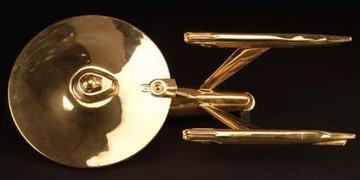
| |
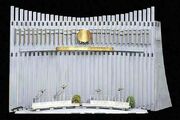
|
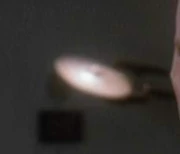
|
A fourth and fifth AMT model kit (most likely No.8617) were used by John Eaves as model and mold for the golden display models in the display cases in the observation lounges of the USS Enterprise-E in Star Trek: First Contact and Star Trek Nemesis as one of the golden models. Preparing them for gold plating proved cumbersome. "Getting them all built was a huge challenge because the kits are just awful to work with, and most of the seams were huge and the choice of part lines put large, deep lines through what should be a clean surface. The Enterprise-A was the worst because it has this kinda wood texture on every inch of the ship, so I wound up filling every line and sanding it smooth to make the finished gold plating look like an Oscar", Eaves remembers on his blog. [40]
Eaves and the studio initially retained most of the models but most of them were later sold at various auctions. One was sold as part of a complete set of six in the Profiles in History Hollywood Auction 44 on 15 May 2011 as Lot 1550 for $11,000 (for the whole set), two were sold in the July 2007 and June 2008 It's A Wrap! sale and auctions as Lot#4411 and Lot #7885 for US$865.00 and US$765.55 respectively, the former to American collector Jason Stevens, [41](X) , one sold as part of a complete set of six in the The Star Trek Auction on 12 December 2001 as Lot 288 to Microsoft's co-founder Paul Allen for his Science Fiction Museum and Hall of Fame in Seattle, now known as the Museum of Pop Culture (MoPop), [42] [43] estimated at US$10,000-$12,000 for the whole set, and another one has reportedly been sold in an on-line Sotheby's auction in October 2000. [44](X)
A silver Constitution II model was seen in Admiral Leyton's office at Starfleet Headquarters on the Presidio in "Paradise Lost". This probably was a painted AMT modelkit No. 8617.
Other commercial products were used as two of the four models mounted in front of the sail shaped top half façade of the Starfleet Headquarters at the Presidio site, appearing in DS9: "Homefront", "Paradise Lost". The top half of the façade was itself a studio model and the starship models were Galoob Micro Machines (most likely taken from the pewter painted "Star Trek Television Series I Box Set" and "Star Trek the Movies Collectors Edition" sets). (Star Trek: The Magazine Volume 1, Issue 13, p. 112) Two Constitution II-class vessels were mounted on the left, a refit configuration the farthest out.
Derivative ship class studio models[]
In Berman-era Star Trek, several other production staffers have also used AMT refit-Enterprise model kits to construct other Starfleet starship classes, intended for on-screen use.
Constellation-class model[]
- See: main article
Deep Space Nine kitbash filming models[]
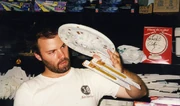
Buckner and the USS Jupp model
Additional AMT modelkits of the Constitution II-class were utilized by Adam Buckner and Dan Curry to "kitbash" the USS Curry and the USS Jupp filming models. [45](X), which were constructed in order to beef out the opening scene of a retreating flotilla of Starfleet vessels in Deep Space Nine's sixth season opening episode, "A Time to Stand". The latter one however, was not present in the scene, though it was prepared for shooting as Buckner later confirmed, "Those photos show the ship while still under construction and the top of the dish had not yet been secured while we were waiting for the neon to be fitted. It was a pain in the patoot, and after that most of that round of kit bashing was done with UV paint and UV tape for windows and nacelles." [46](X) Only the USS Curry (with Constitution-class warp nacelles) made it onto the screen, though the USS Jupp, as were most of the other Deep Space Nine kitbashes, went on to be featured in the Star Trek: Deep Space Nine Technical Manual.
CGI refit models[]
Two very early CGI models of a Constitution II vessel were built in 1981, (this one was in fact one of the two very first CGI starships ever constructed for the Star Trek franchise), and in early 1987 respectively, but both have not been seen by the general public until one of them resurfaced in 2013.
The Wrath of Khan evaluation and display CGI models[]
The first CGI model was built in 1981 as a probation piece at the Graphics Group to convince mother company ILM and Paramount Pictures to go ahead with what would eventually became the "Genesis Demo". Project leader Alvy Ray Smith recalled, "It should be mentioned that we had already done one "mini-production" (in August '81) for ILM to show off our abilities. We had rendered a model of the Starship Enterprise chasing a Klingon ship in 3-dimensions, with appropriate lighting, coloring, etc. This was done using Loren's first working version of his 3-D rendering program "Reyes" ("Renders Everything You Ever Saw"). This mini-production had also featured several 2-D effects programmed by Pat Cole and Rob Cook. We believe that this demonstration was what prompted Paramount and ILM to ask us to do a piece of the final film." (American Cinematographer, October 1982, p. 1038) Footage of this version has yet to resurface.

Sutherland's CGI model as targeting graphic display
A second CGI model was constructed by Evans & Sutherland albeit rendered as a simple wire-frame model only, as it was intended to serve as an animated computer display graphic only. Sutherland's model was featured on the main viewing screen in the Kobayashi Maru scenario and on the bridge of the USS Reliant as graphic display on its targeting computer. (Star Trek II: The Wrath of Khan (The Director's Edition)-special feature: "text commentary")
The Next Generation's evaluation CGI model[]

|

|

|

|

|

|
A third one was built at the start of 1987 during the early stages of pre-production of the new Star Trek: The Next Generation series, when it became apparent to producers Robert H. Justman, Edward K. Milkis, and then recently-appointed associate producer Peter Lauritson, that the new show would be the most VFX-laden show of its day, much like its predecessor was. At a point they considered doing the special effects and especially the ship shots in CGI as a time saving alternative and went as far as to have an effects company compile several test shots. Since the new ship for the show was yet to be designed, a Constitution II vessel served as a stand-in. Justman recalled, "Eddie Milkis and I investigated the possibility of generating everything on the computer. We had great reservations about it, because it still didn't have the reality. The surface treatment wasn't totally believable; we could have gotten by, it would have been acceptable, but it wasn't satisfactory." (Star Trek: The Next Generation USS Enterprise NCC-1701-D Blueprints, accompanying booklet, p. 14; Cinefex, issue 37, p. 10) Milkis further elaborated,"It was incredibly good, and it took some real thinking on our part, but ultimately we decided that if something ever happened to that company and they couldn't deliver, then we'd have nothing. We were very concerned about that and ultimately they did go out of business." (Star Trek: The Next Generation Companion (1st ed., p. 11))
The footage was dismissed as inappropriate and stored away as archival property, never meant to be seen again. Yet 25 years later, when Value Added Material (VAM) Producer Robert Meyer Burnett was doing his research for the 2012 remastered The Next Generation project, he did stumble upon this footage,
"I’ll tell you one of the things we’ve found that is pretty exciting – we haven’t used it yet – when The Next Generation was first talked about, they had to figure out how they were going to do the visual effects. There was talk at the time – this was just a couple of years after The Last Starfighter, when they did all those space visual effects v that there was talk about going all-CG. In 1987. Various effects houses did a sort of bake-off, where they were given some footage from Star Trek III to do transporters and phaser fire… then they were asked to do CG models of the Enterprise. So we have these tests that these various effects companies did of visual effects – what the visual effects would have looked like had they been all CG. Ultimately, they were a little, uh, crude –to say the least – so they opted not to go that route, and they opted to go with models and motion control, THANK GOD, but we have this footage, and we’re going to use it on one of the subsequent releases. We don’t know when, because it’s not season-specific, but it’s crazy to have! It’s just something that was on a tape, Angelo found a box with tapes in it, we looked at the tapes, and there was this footage. Roger and I…one of the great, fun things about this project is that we get these tapes, and we just look at each other like "Oh my god, no one’s ever looked at this stuff! Ever!" It might just be snippets, but even if we’ve got one shot of a Nagilum test…we try and use shots of everything we’ve got, but the Nagilum test, to me – having [actor] Earl Boen and all that – just being able to see, is great! Because it’s never shown up in books anywhere, and just to have it all…" [47]
Burnett eventually made good on his promise, though the footage was ultimately released to the general public in a way he did not quite envision. In the end the footage was presented by CBS Consumer Products to a small privileged audience on an extremely limited basis as the retailer exclusive only special feature, "The Trek Not Taken; First Steps into the Digital Frontier", of the 2013 TNG Season 3 Blu-ray release, therefore invoking the ire of the vast majority of fans and costumers, not able to access or even purchase the special feature.
The Director's Edition CGI model[]
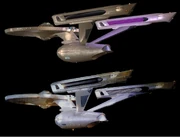
Dochterman's CGI model of the refit USS Enterprise (top) compared to a publicity still of the filming model (bottom)
For the Director's Edition DVD of the original film, new VFX shots were needed among others new shots of the Enterprise herself. Daren Dochterman, primary liaison between digital effects company Foundation Imaging and production company Robert Wise Productions, and as supervisor already in charge of most of the VFX, built and mapped a model in his spare time. [48] "I did my best to come up with a workable ship. I used my model in some rough composites as we were storyboarding it and it looked OK. But specifically for end shots it had to be much more detailed. So I handed that model over to the guys at Foundation Imaging." (Star Trek: The Magazine Volume 2, Issue 8, p. 55) At a later point in time Dochterman added, "The main guys responsible for this beauty on the DE were Lee Stringer and Rob Bonchune…I did the first test model from scratch, then it was uprezzed (primarily the primary hull) using some of Jose Perez's work, and I think Koji did some stuff on it too, if I recall correctly. I sure wish we had had the time and resources that Warner Brothers had allotted to the Blade Runner redux. That would have been great. And it would be on 1080p Blu-Ray as we speak…" [49](X) As it turned out, Dochterman's last remark, made in 2009, became moot when only a remastered edition of the movie's original theatrical version was released one year later, as it became clear that Paramount Pictures had failed to retain ownership of the CGI elements after Foundation Imaging went bankrupt and all the servers along with the entire digital content content were sold off. [50]
At Foundation, an additional CGI model was constructed by Jose Perez, while the work of mapping and lighting the model was handled by Robert Bonchune and Lee Stringer. Having access to the original studio model Bonchune remarked, "there were just these subtle variations everywhere that gave it so much depth and reality. ILM had matted the surfaces down for bluescreen photography. but they left a few parts of the 1979 paint job near the back. There were layers and layers of subtle airbrushing and a little pearlescent here and a little less there. I was told by some of the guys who originally did the paintwork that they took white and 15 or 17 different colors like pink and blue and magenta, all these different shades, and just put a few drops in each of the paints."
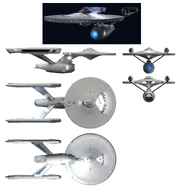
Foundation's completed CGI model
In the end, Stringer worked on the saucer section, while Bonchune worked on the rest, both working on it in their own time. [51](X) Stringer further specified, "To help create this, Foundation Imaging was charged with creating and completing many visual effects shots and scenes. A version highly detailed computer model of the USS Enterprise was required. Starting with two CGI models provided by VFX Supervisor Daren Dochterman and Jose Perez, I was responsible with creating the Primary Hull (Saucer), the Bridge and Warp Nacelles (Engines). Helped by having unlimited access to the original filming miniature, the finished model replicates the look and details of the filmed version to blends the new elements and shots seamlessly into the film." [52] To underscore the collaborative character of the effort, Dochterman has additionally stated, "The first thing I did was to do a movie version of the Enterprise in LightWave 3D(…), but only for tests…To insure that the model would be indistinguishable from the filming model, I handed it over to CG artists Rob Bonchune and Lee Stringer, then of Foundation Imaging. With the addition of a 3D model by modeler Jose Perez, the model is a combination of all our talents." [53]
Foundation's model went on to make several appearances in and onto several licensed Star Trek publications, such as Star Trek: The Magazine, Star Trek: Starship Spotter and, more notably, the Star Trek: Ships of the Line calendars and their book derivatives, but most prominently in several issues of the British partwork publication Star Trek: The Official Starships Collection. (See: below)
Constitution II-class shuttlebay models[]
While Jefferies had a more modest view in mind where the scale and location of the hangar bay were concerned in the original configuration, when it came to redesign the Enterprise for The Motion Picture, designer Andrew Probert had a far more ambitious configuration in mind. Probert, after taking over the interior design work from Mike Minor, who had done some preliminary design work, asked himself where the workbees went, once having entered that space, "This 'new idea' was based on my discussions with Trumbull as we examined the logic of those earlier concepts. My first question was, "How do those pods get in & out of that space?" Eventually, I produced this elevation sketch to propose a solution,…and Trumbul [sic] liked it." [54](X)
The thinking was that the hangar deck was interlocked with staggered adjacent cargo bays and as such were envisioned. Eventually, though liked by Trumbull, the whole set-up was realized by combining matte painting and a (small) partially full-scale set for the actors to interact with, as executing the whole effect as a full standing set would have been cost-prohibitive.
The Motion Picture maquette[]
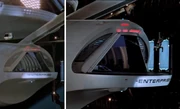
The Motion Picture hangar deck maquette. Notice the sliver of blue-screen, indicating the maquette did not quite match up with the angle of the shots
While a full scale set was not executed, a small scale partial maquette was, as was evidenced in a 2011 blog entry:
"So, coincidentally, I had breakfast this morning with Mark Stetson and he confirmed that the Enterprise filming miniature had:
- A rear mount. (I confirmed this separately in a miniatures manual the Magicam prepared for the handover to ASTRA and EEG.)
- Replaceable hangar bay doors. One set "closed", another set "open".
- A physical model for the interior. It was forced perspective and not very deep. Was basically a floor, the starboard wall with some ribs, and a couple of work bees. They went with a miniature because as opposed to a painting because they knew the camera would be moving and there needed to be something there to have some parallax (depth).
He knows this because he was (coincidentally) the guy that built it." [55]
Daren Dochterman has added on the same occasion, partly in error where the workbees were concerned, "The Miniature did have a partially built shuttle bay… but was augmented with a tiny matte painting of a couple of workbees that was mounted inside the miniature itself… as you can see in one shot as they pass by. I believe this is what Mr. Probert means when he said it was a combination of matte and miniature. (of course, when we are inside, it is entirely matte painting.)" [56]
Nonetheless, it turned out that Stetson himself had already elaborated on the maquette in a 1979 interview – which only became published in 2014, "There were some things add to the Enterprise that were not built into the model at first. Take the hangar bay shot when the Enterprise is in drydock. The hangar bay was open, and that was sort of a last-minute addition. The hangar bay doors were removable to reveal another armature opening, and so I had to mock up a little miniature that we could insert in the model to indicate an open area ther. That had some detailing in it which wasn't revealed in the way it was shot." (Return to Tomorrow - The Filming of Star Trek: The Motion Picture, p. 384)
The footage was re-utilized in The Wrath of Khan, but the maquette itself has not been auctioned off with the main model, and – like Magicam's small filming model – was never sighted again afterwards, presumably lost.
The Final Frontier maquettes[]
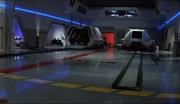
The full-scale shuttle bay set with the mock-ups
In Star Trek V: The Final Frontier, the flight deck had an important role to play. Such was its perceived importance that for the first and last time, a full scale set of the Constitution II-class hangar deck was constructed, complete with two full-scale mock-ups of the Galileo-type shuttlecraft, and tailored on Jefferies' original vision, as the elaborate vision of Probert was not called upon. "This is a new set for Star Trek, and it fulfills a very important function in the life of the Starship Enterprise in that this is where the shuttlecraft depart from and return to. The set took up all of Stage 8, which is perhaps the biggest stage on the Paramount lot. we had a couple of full sized shuttlecraft in the landing bay, including the one we flew on location in the desert.", cinematographer Andrew Laszlo reiterated. (American Cinematographer, July 1989, p. 64)
Filmed by "Associates and Ferren", it was initially hoped that all the flight-deck sequences could be done using the full-scale hangar deck set and the Galileo-type shuttlecraft mock-ups. As Effects Supervisor Mike Woods recalled, "All of a sudden, we were presented with this 8,000 pound shuttlecraft – when it's empty – then they stuffed ten or twelve people in it and expected us to make it fly! It was too heavy to use wires, but we were able to hook it up to an airwinch to pull it through the shuttlebay about fifty feet. It was on castors so we could slide it in and out, but the darn thing was very difficult to manipulate. For shots where we just see its nose, we had people pushing it from behind. It was all shot forward motion, as the craft skidded and crashed, knocking the pylons off on either side. We had a cargo net hung at one end to keep the shuttlecraft from crashing intro the set." Bran Ferren, the CEO, eventually had to accept the inevitable, "No matter how much we didn't want to intercut between models and live action, we ended up having to do it here." Elaborating why he was not a big proponent of having to use the live set/maquette combination, Ferren continued, "There's so much you can do wrong when intercutting between a giant set and a miniature. For example, Andy Laszlo designed a nice effect of several hundred running lights in the set which made things quite difficult from a model and miniature point of view. Try matching those on a miniature set you're shooting at F-22 at 100-200 frames per second! We had to duplicate the on-set incandescent bulbs in miniature which decayed off instead of blinking off, which meant we needed a terrifying amount of light output from our miniature bulbs. We ended up using hundreds of little 12 volt MR16 reflector lights with a pulsar we designed so we could hit them with about 130 volts of power for a millisecond, superheating them to several times their normal brightness, and limiting the peak energy with a controlling computer so we didn't detonate the lamps! It's little things like that which you don't think much about that you know will be a killer." (American Cinematographer, July 1989, pp. 78-79)
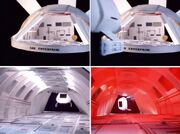
The shuttlebay camera test model being put through its paces
Once the decision was made, Ferren's company built camera test models of both the shuttlebay and the accompanying shuttlecraft (affectionally dubbed the Guido II) while construction of the actual models was underway. Apart from determining camera angles, velocity and camera speed for the pyrotechnic effects, the tests were also undertaken to establish if the shuttlecraft miniature would survive the crash, as related by Motion Control Expert Peter Wallach, "One of the main reasons some wanted me to shoot the crash motion control was they were concerned we'd break the model doing it our was." (American Cinematographer, July 1989, p. 80) The test models and the test performed are featured on the Star Trek V: The Final Frontier (Special Edition) DVD, "Pre-Visualization Models" special, disc 2.
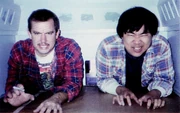
Jein and then-employee John Eaves (l) posing in the large, still unfinished shuttlebay maquette
Construction of the landingbay maquette fell to Gregory Jein, Inc., specifically assigned by Ferren & Co. Jein actually constructed two maquettes of the landingbay. One maquette was constructed in a scale to interact with the 1:12 scale (2½ foot) Galileo shuttle model for the exterior in-flight sequences. The second one was scaled to the more important 5 foot models in regard to the interior crash sequence. Jein recalled, "The actual hangar interiors we made were only background pieces, so the camera will not dwell on them for too long – it's just something you see the shuttle crash against. The most demanding part of the job was the space problem in my little shop! The 1/12 scale set was so big, we had to take the door apart to get it out of there! The 1/6 scale shuttlebay was over 20 feet wide, but we built it in sections like stage flats that bolted together, so it fit through the door easily once it was dismantled. Both sets were constructed of plywood, like big dollhouses." (American Cinematographer, July 1989, p. 80)
Once constructed, the maquettes were shipped eastwards and handed over to Wallach's effects team, who had to figure out how to execute the crash scene. Wallach recalled:
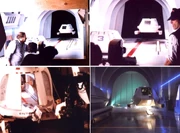
|
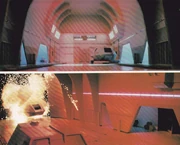
|
"Though we did some 75 shots using motion control, it was my belief you can't do a crash convincingly using motion control, so we built a giant slingshot made from two 22'rails and a sled with rollerskate wheels on it. One has to be flexible with motion control and realize that there's a time to use it and a time not to. One should never lose sight of the fact that a simple rubber band can be a lifesaver. In this case the "rubber band" was a couple of two ton garage door springs cocked back by a three and a half ton winch. We pulled this slingshot back varying distances. Prior to launching this $10,000 shuttle at a $100,000 shuttlebay, we built the "Guido II" – a plywood mockup of the shuttlecraft – which we fired a number of times to determine the best velocity and camera speed for the pyro as well as the scale.
"One of the main reasons some wanted me to shoot the crash motion control was they were concerned we'd break the model doing it our way… My attitude was just to put a little more fiberglass in it and catch it so it wouldn't break. We were having so much fun doing it, we wound up doing six takes in all, and in six takes there was no damage to the model. It was just a paint job away from being ready for the next take. We only needed about 45 minutes between takes.
"Two highspeed cameras encased in plexiglass booths within the shuttlebay itself recorded the action from the front and side, as the shuttlecraft plunged at breakneck speed. The shuttle sled was cocked back six and a half feet, then released, launching the model at about 300 miles per hour–on fire. Inside the shuttle was a control box which triggered a series of explosions on the ship at half-second intervals. We shot the shuttle head on at 72 frames per second, which is low-end high speed. Usually, high speed miniature photography means something like 300 frames per second, but if we had to shot this much beyond 72 frames, it would've made the sparks look a little phony.
"The side shot went by rather quickly, so we cranked that up to 90 frames per second. We also got creative for one shot, where we cut a hole in the set and mounted a front silvered mirror at a 45 degree angle, which enabled us to shoot the shuttlecraft coming directly into camera almost as if it was shot right between your eyes. After it whizzed by the cameras, the shuttle wedged itself into an ice cream cone shaped funnel of foam rubber which we designed to stop it, and my pyro crew stood by with fire extinguishers to put it out. It was a very exiting shot. By launching it for real, we added a much greater sense of realism to the effect than it would've had if we used motion control. It also enabled us to meet a very difficult production schedule in that the shot was composited all as one." (American Cinematographer, July 1989, p. 80)
Like their illustrious predecessor, neither model, due to their sizes, are currently known to have survived, though they appeared not to have been destroyed immediately after the production wrapped, as at least one of them has been sighted in storage at the Paramount lot in the late summer of 1989. [57]
Appendices[]
Related topics[]
Further reading[]
- Starlog photo guidebook Special Effects
- "The Enterprise", David Hutchison, Volume 2, 1980, pp. 92-98
- "Entertainment Visual Design: A Look Back", Andrew Probert, Volume 5, 1996, pp. 88-113
- The Art of Star Trek, November 1995
- "Redesigning the U.S.S. Enterprise NCC-1701", Ben Robinson, Star Trek: The Magazine Volume 2, Issue 8, December 2001, pp. 84-87
- Star Trek: The Official Starships Collection
- Issue 2, September 2012
- Issue 72, May 2016
- Bonus issue 06, January 2018
- XL Special issue 06, June 2018
- Star Trek: Creating the Enterprise, December 2012
- Return to Tomorrow - The Filming of Star Trek: The Motion Picture, December 2014
- "Chapter Three: The U.S.S. Enterprise – Evolving the classic Starship", Star Trek: The Motion Picture - The Art and Visual Effects, September 2020, pp. 40-65
External links[]
- Redesigning the Enterprise at Forgotten Trek: about the design of the refit Enterprise for The Motion Picture
- Redesigning the Enterprise at the Federation Starship Datalink
- The Enterprise Refit of 2271 at Ex Astris Scientia: analysis of the several modifications performed on the Constitution-class
Original featured revision (1146929) • Diff to split • Split to current • Last featured revision (1575821) • Diff to current • Blurb


